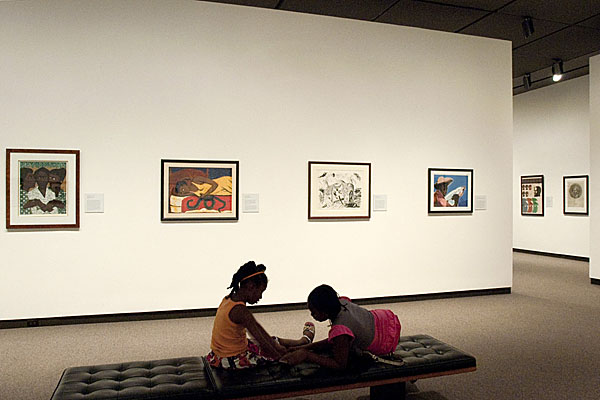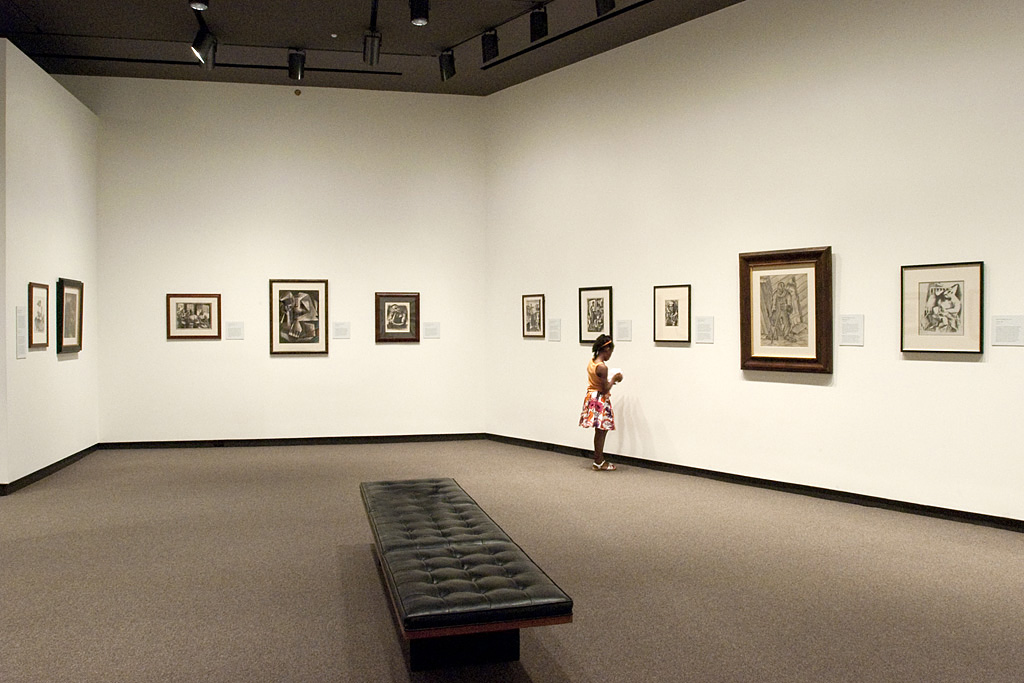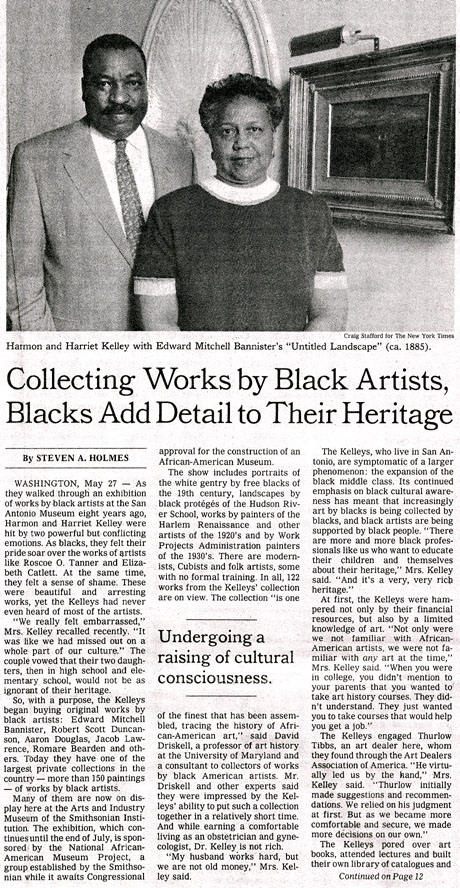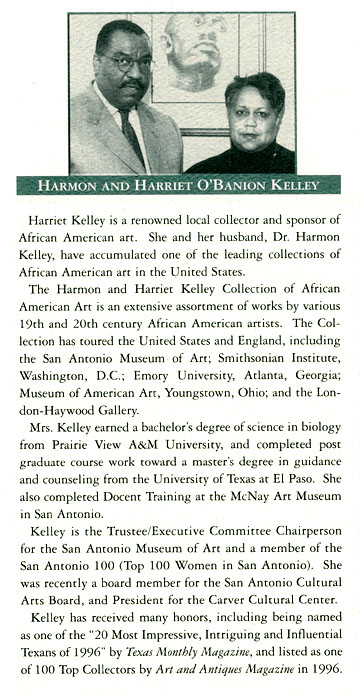Ron Adams (born 1934)
Blackburn, 2002
Color lithograph
Edition no.: 55/80
Image size: 25 x 35 in.;
Framed: 43 x 33 in.
|

|
Ron Adams (born 1934)
Endangered Species II, 1991
Aquatint and line etching
Edition no.: 12/60
Image size: 24 x 17-¾ in.;
Framed: 35-3/4 x 28-1/8 in.
|
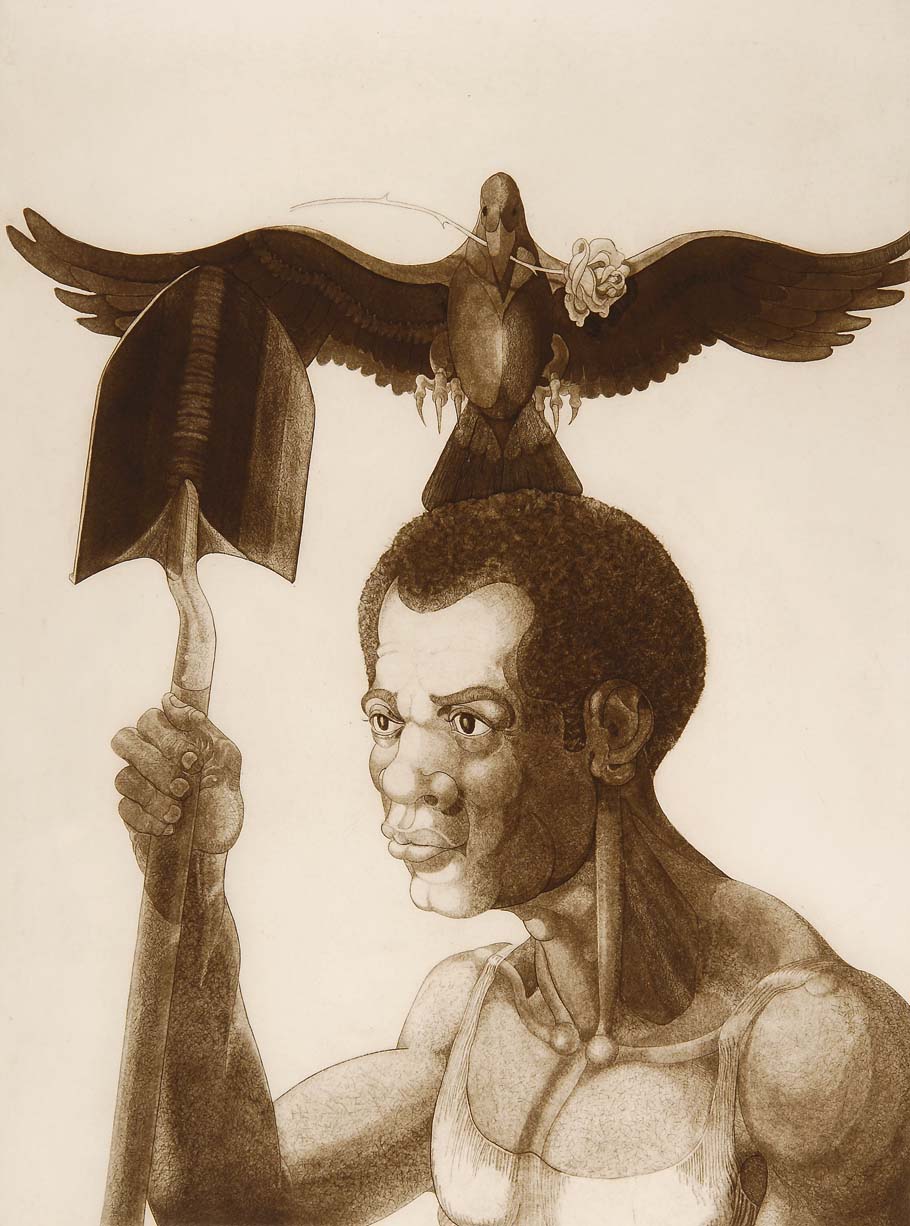 |
Benny Andrews (1930-2006)
Reverend Love of Atlanta, 1972
Pen and ink on paper
Image size (sight): 17 x 11-3/8 in.;
Framed: 23 x 17 in
|

Benny Andrews: Art © Estate of Benny Andrews/Licensed by VAGA, New York, NY |
Romare Bearden,
(1914-1988)
Conjunction, 1979
Lithograph,
Edition of 300
Image size: 28" x 22"
|
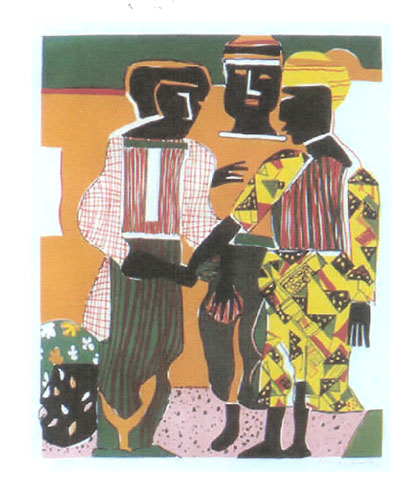
Romare Bearden: Art © Romare Bearden Foundation, Inc/Licensed by VAGA, New York, NY
|
John Thomas Biggers (1924-2001)
Morning is Here, No Dawn, 1965
One color lithograph
Edition no.: 5/11a
Image size: 17-3/4 x 13-3/4 in.;
Framed: 27-1/2 x 22-1/2 in.
|
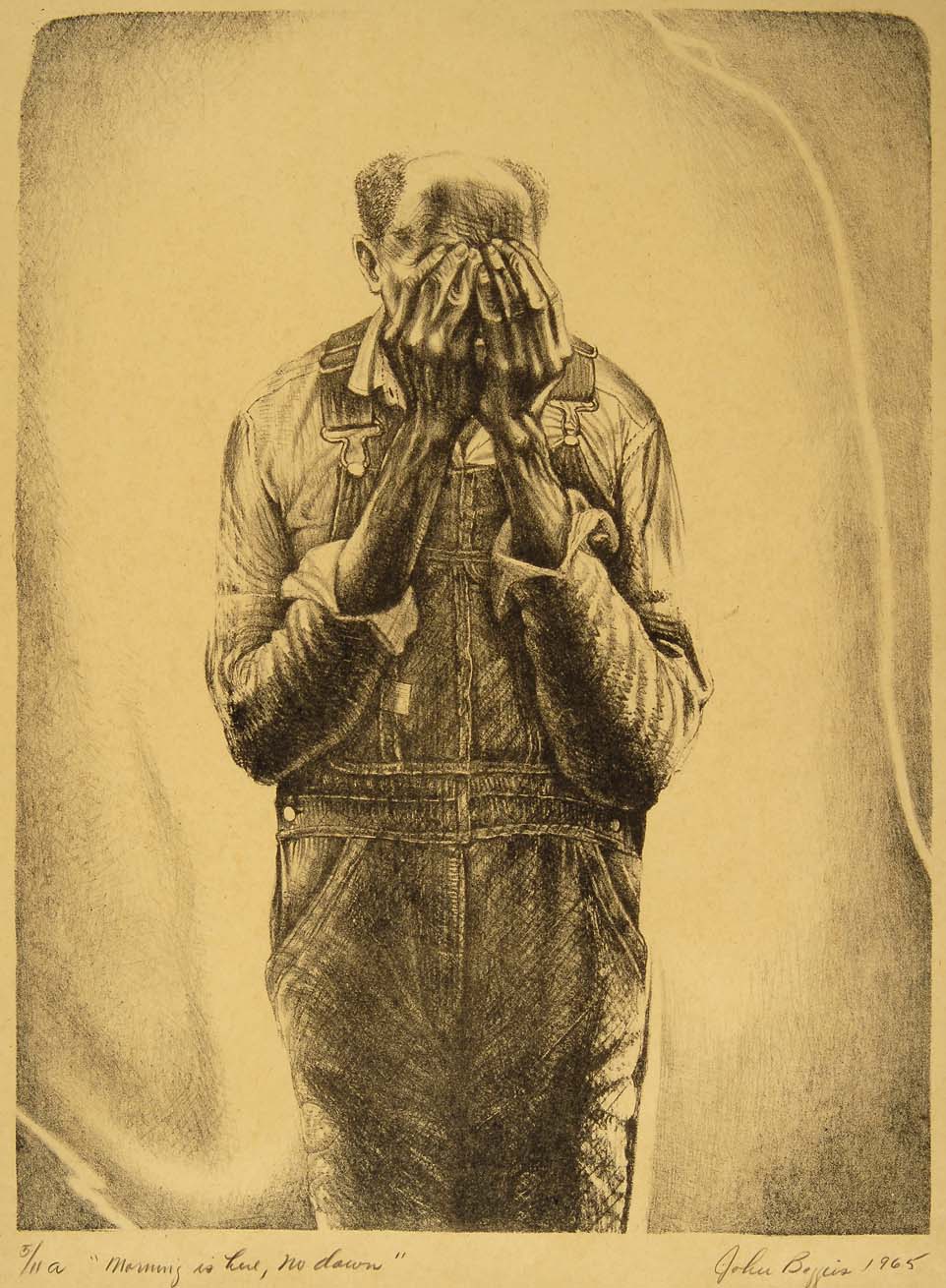
John Biggers: Art © John T. Biggers Estate/Licensed by VAGA, New York, NY |
John Thomas Biggers (1924-2001)
At Risk., 1996
One color lithograph
Edition no.: 23/70
Image size: 15-5/8 x 11-7/8 in.;
Framed: 33-1/2 x 27 in.
|

John Biggers: Art © John T. Biggers Estate/Licensed by VAGA, New York, NY |
Robert Hamilton Blackburn (1920-2003)
A Portrait, 1959
Line etching and aquatint
Image size: 7 x 5 in.;
Framed: 21-1/2 x 17-1/4 in.
|
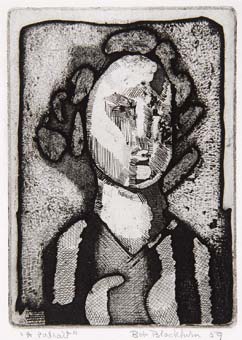 |
Elmer W. Brown (1909-1971)
Numbers Pulling, 1935
Linoleum cut
Edition no.: 2/50
Image size: 9-1/2 x 6 in.;
Framed: 21-1/4 x 17-1/4 in.
|
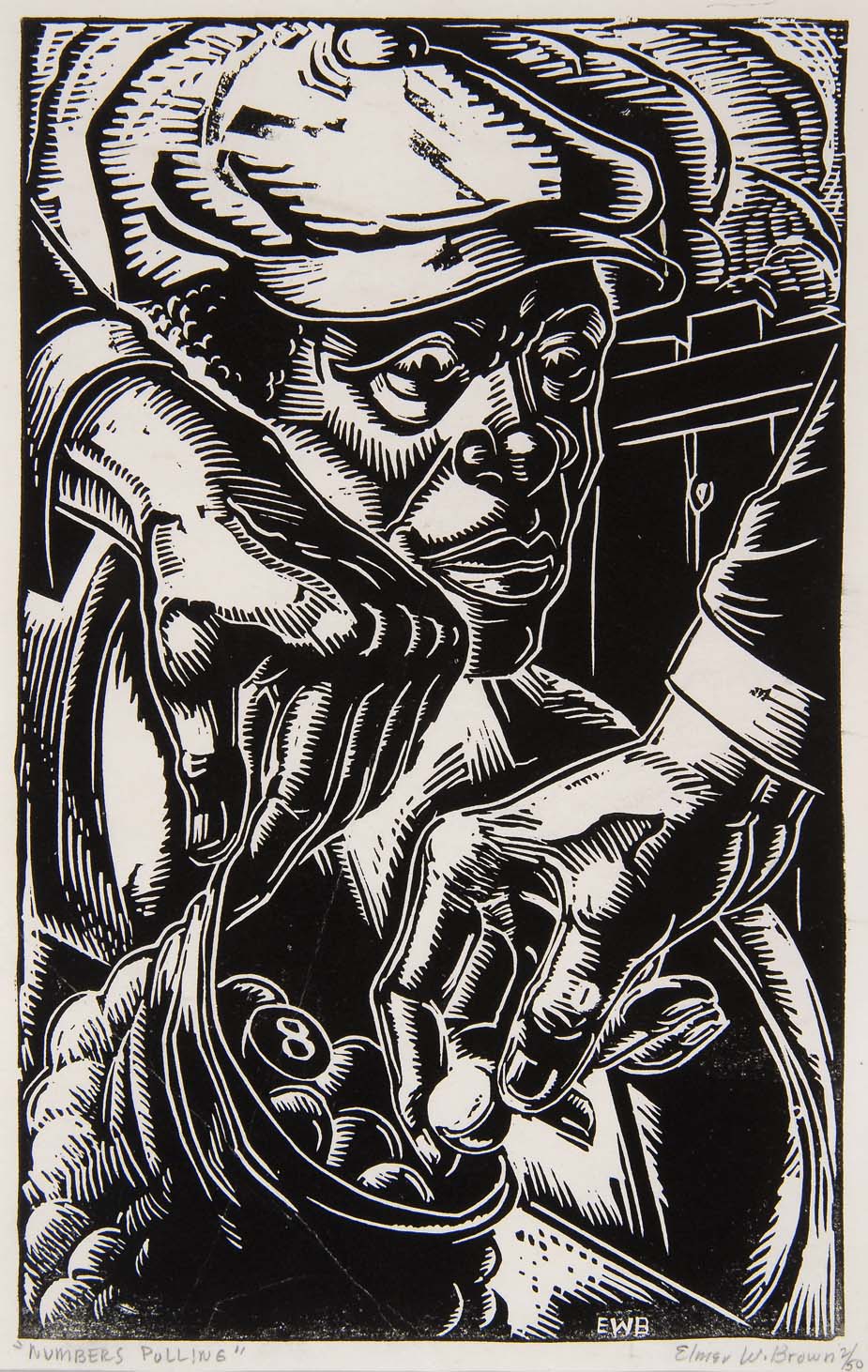 |
Hilda Wilkerson Brown (1894-1981)
The Family, c. 1940
Lithograph
Edition no.: Artist's Proof
Image size: 13-7/8 x 9-1/2 in.;
Framed: 23-3/4 x 19 in.
|
 |
Grafton Tyler Brown (1841-1918)
Willow Glen Ranchero," Residence of T. W. Moore,
Pescadero, San Mateo County, California, c. 1800s
Lithograph with hand-coloring
Image size: 26-1/4 x 12-1/4 in.;
Framed: 22 x 35-1/2 in.
|
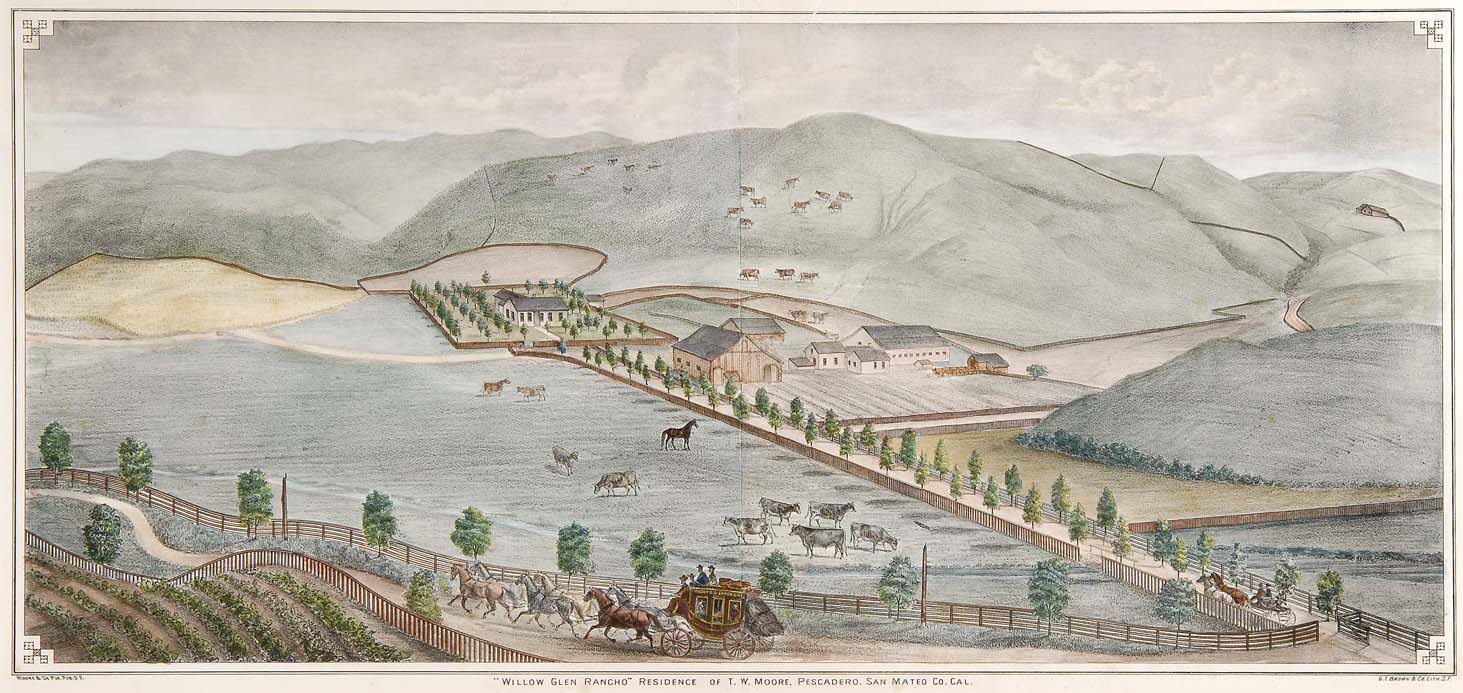 |
Calvin Burnett (1921-2007)
Juggler, 1948
One color line etching
Edition no.: 2/10
Image size: 9 x 5-7/8 in.;
Framed: 18 x 14 in.
|
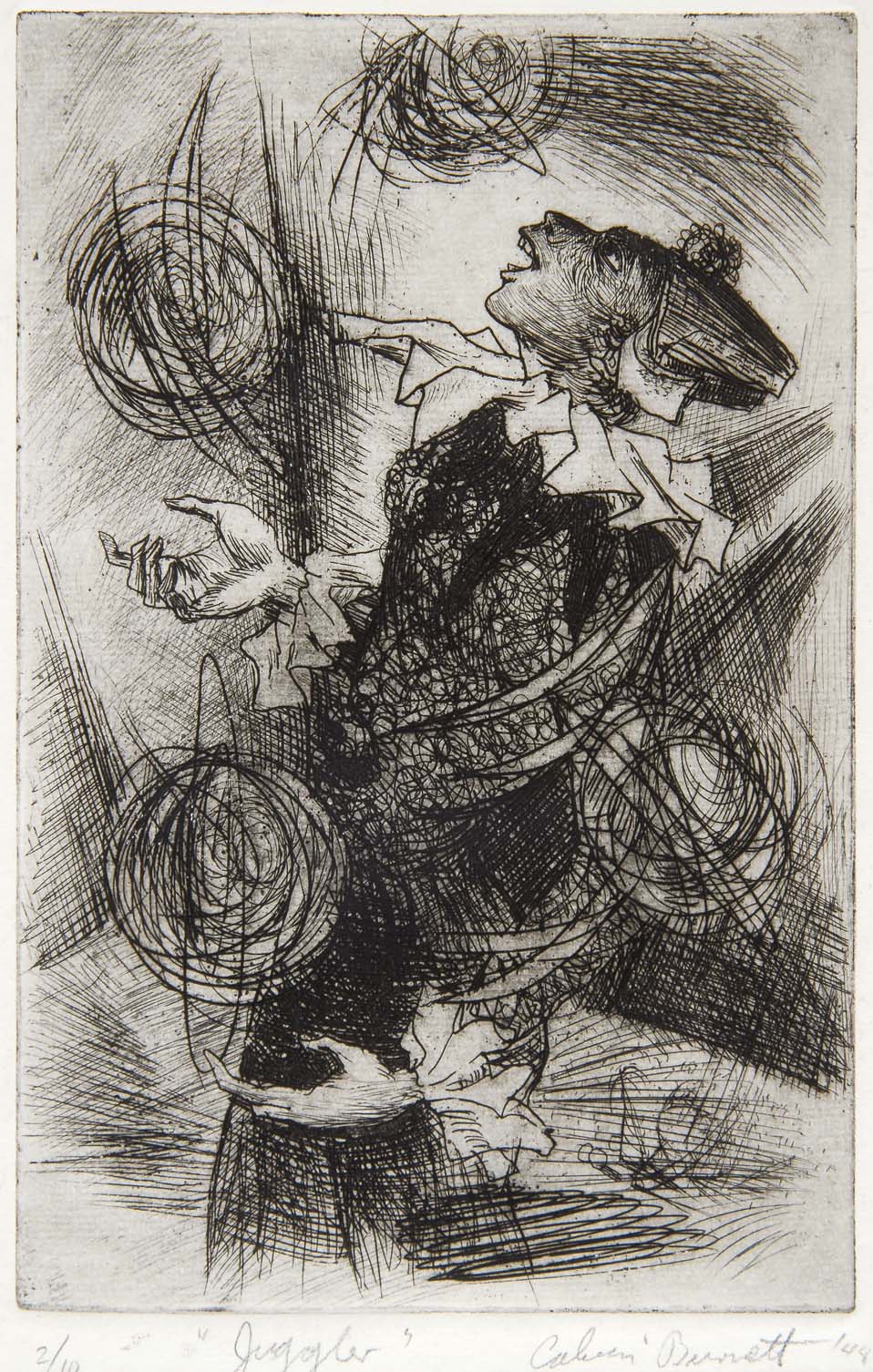 |
Margaret Taylor Burroughs (1917-2010)
Youth, 1953
Linoleum cut
Image size: 12 x 10-3/4 in.;
Framed: 21 x 19-1/2 in.
|
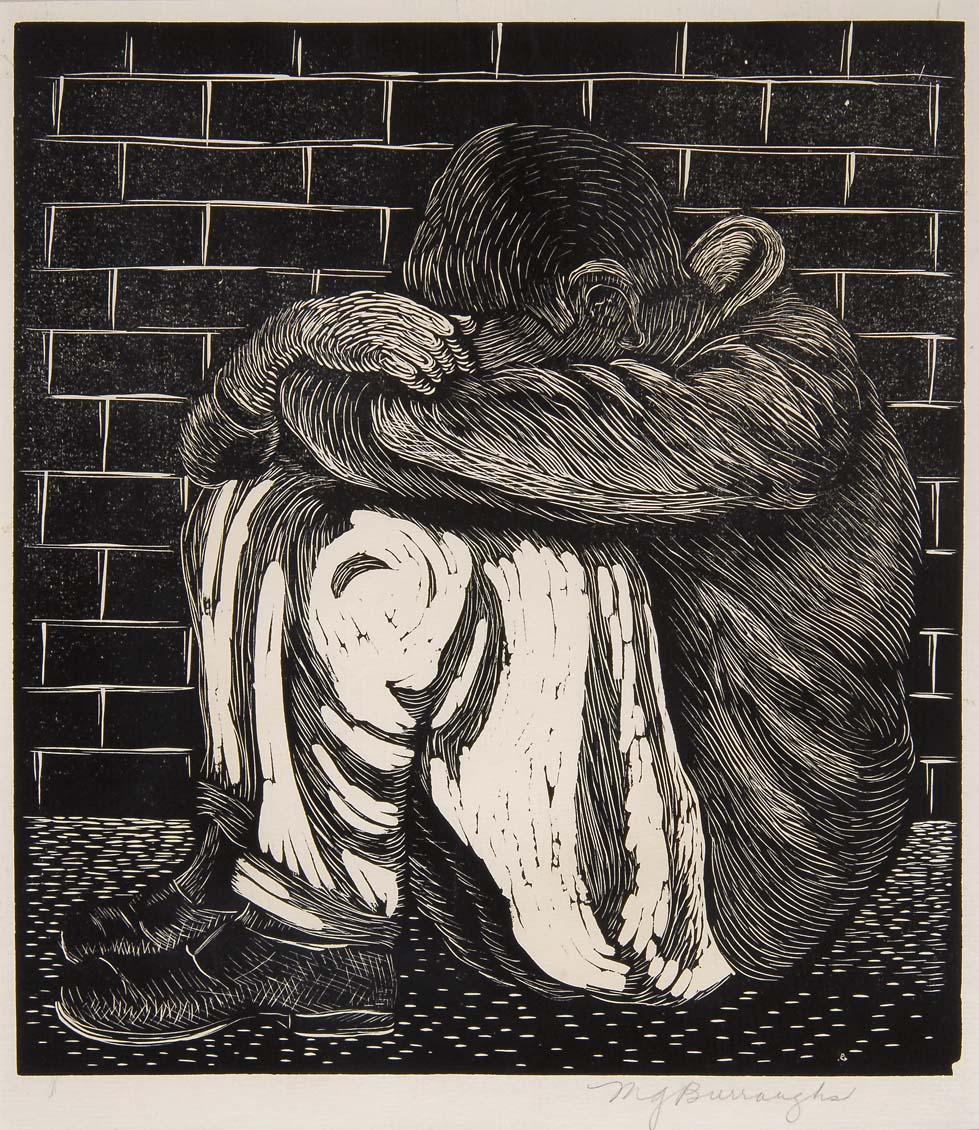 |
Elizabeth Catlett (1915-2012)
Malcolm Speaks For Us, 1969
Four color linoleum cut
Edition no.: 13/35
Image size: 35 x 27-3/4 in.;
Framed: 31 x 40-3/4 in.
|

Elizabeth Catlett: Art © Catlett Mora Family Trust/Licensed by VAGA, New York, NY |
Elizabeth Catlett (1915-2012)
Sharecropper, 1952
Two color linoleum cut
Edition no.: G/P
Image size: 17-5/8 x 16-7/8 in.;
Framed: 27-1/4 in. x 26 in.
|
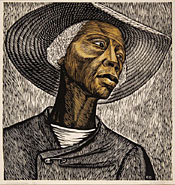
Elizabeth Catlett: Art © Catlett Mora Family Trust/Licensed by VAGA, New York, NY |
Claude Clark (1914-1985)
Rain, not dated
Offset lithograph
Edition no.: 43/400
Image size: 15-3/4 x 20 in.;
Framed: 29 x 32-3/4 in.
|
 |
Robert Colescott (1925-2009)
I Can't Dance, 1996
One color lithograph
Edition no.: 23/70
Image size: 25 x 18-1/8 in.;
Framed: 24-1/2 x 27-1/4 in.
|
 |
Eldzier Cortor (born 1916)
Dance Composition #35, not dated (early 1990s)
One color aquatint and line etching
Edition no.: A/P (Artist's Proof)
Image size: 23-7/8 x 21-5/l8 in.;
Framed: 36 x 34 in.
|
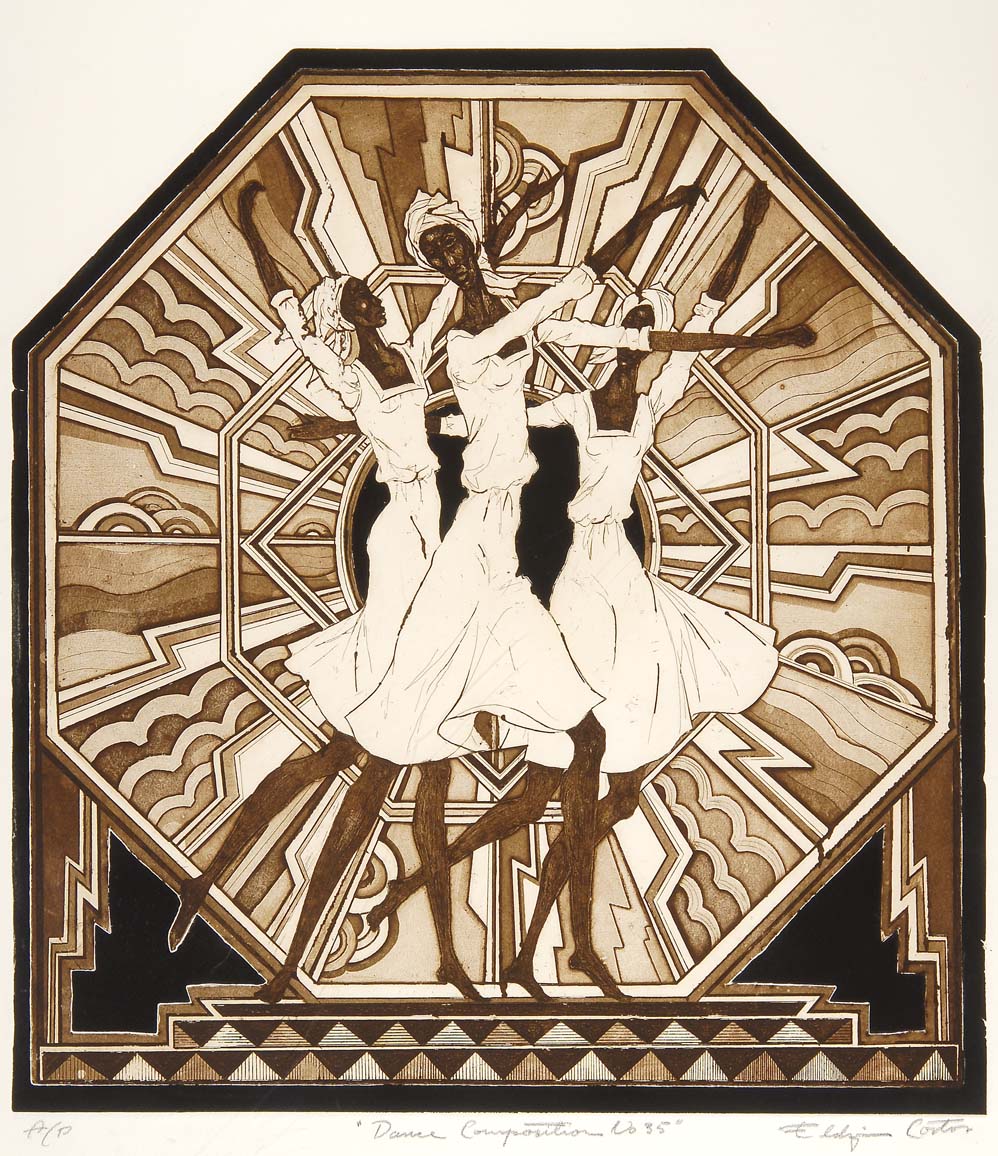 |
Ernest T. Crichlow (1914-2005)
Anyone's Date, 1940
Gouache on paper
Image size: 9 x 7 in.;
Framed: 18-3/4 x 16-3/4 in.
|
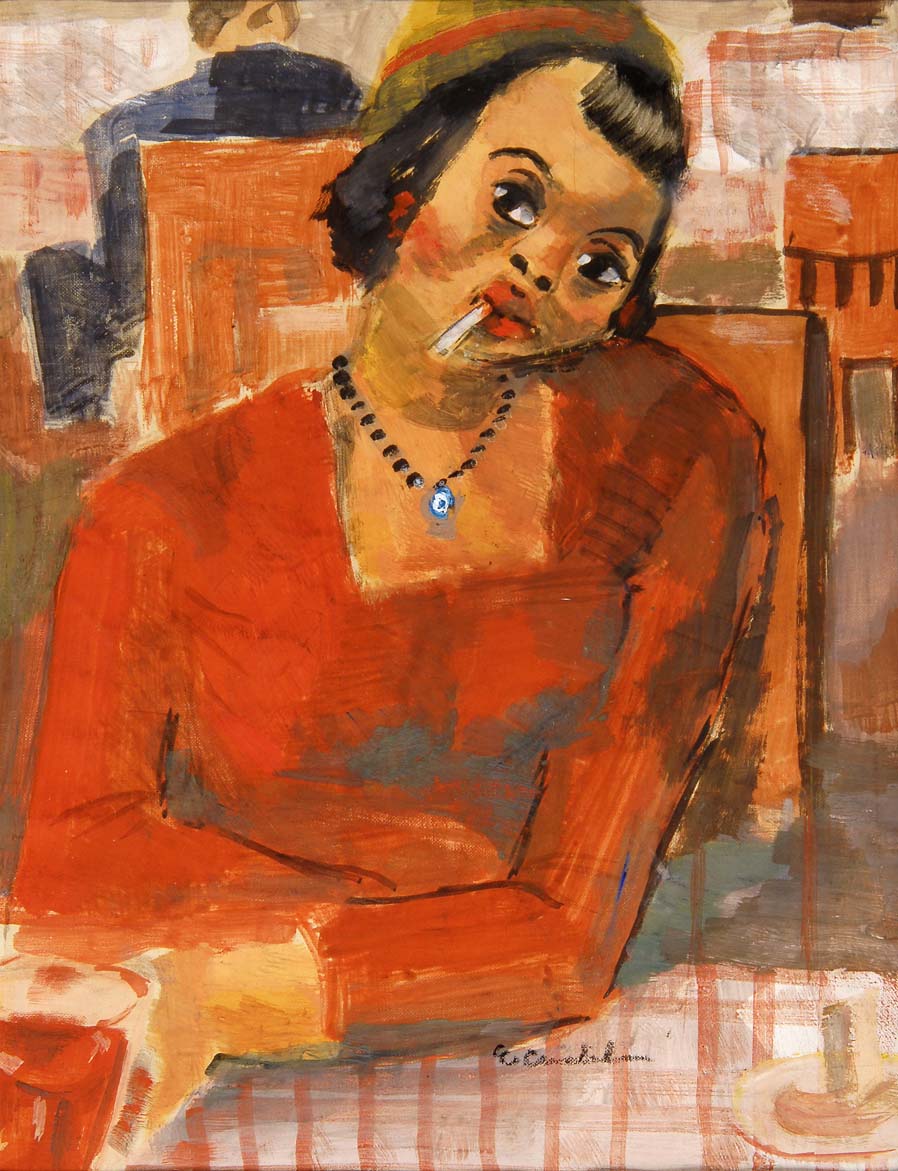 |
Ernest T. Crichlow (1914-2005)
Lovers, 1938
Lithograph
Edition no.: W.P. (Working Proof)
Image size: 14 x 11-1/2 in.;
Framed: 25-1/4 x 22-1/2 in.
|
 |
Charles Criner (born 1945)
Mr. Alvin White (Man with Chicken), 1998
Color screen print
Edition no.: 29/50
Image size: 17-3/4 x 22-1/2 in.;
Framed: 24-3/4 x 29-1/2 in.
|
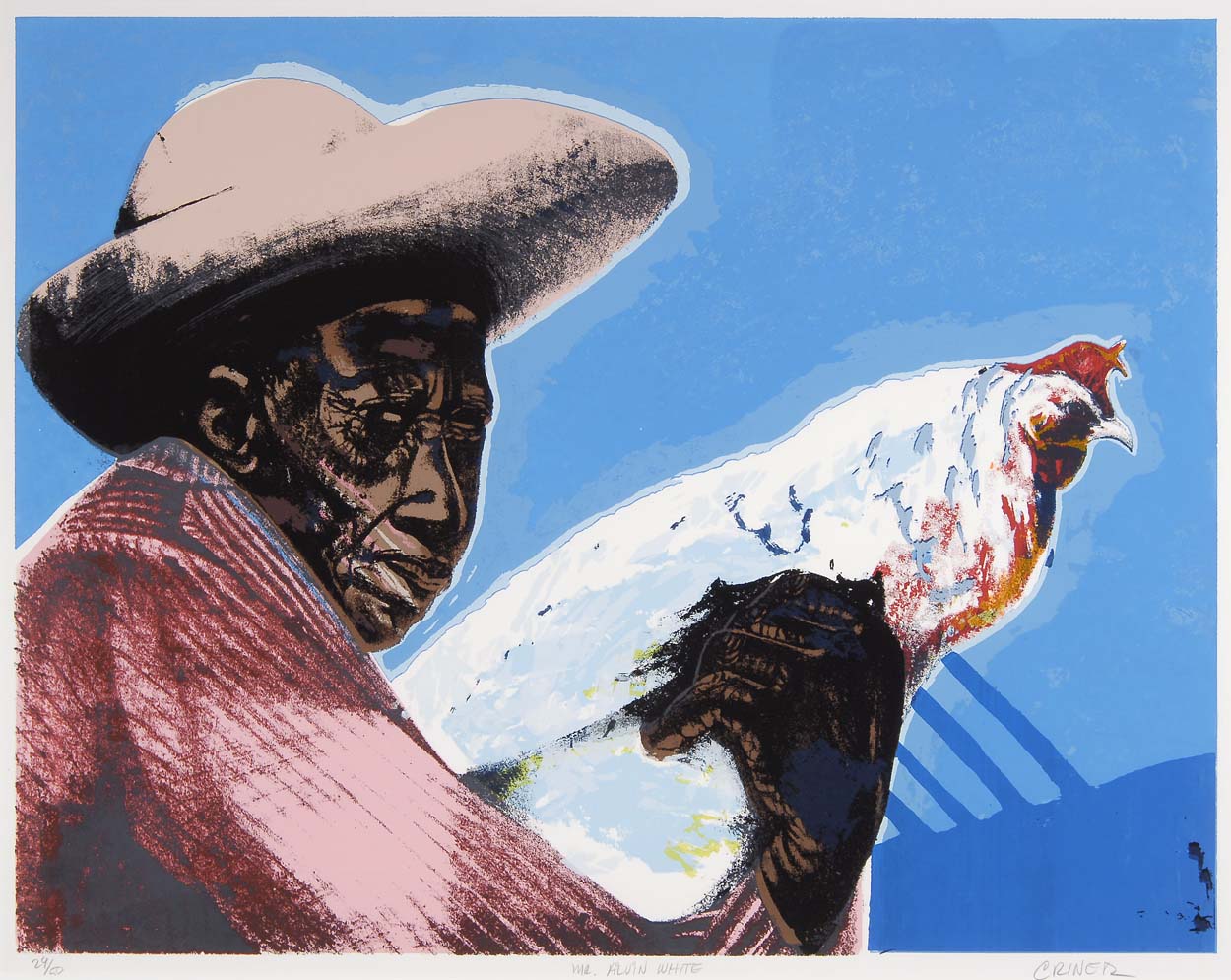 |
Mary Reed Daniel (born 1946)
My Friend, 1981
Gouache, graphite, and acrylic paint on paper
Image size (sight): 11 x 9-1/8 in.;
Framed: 14-1/2 x 12-1/2 in.
|
 |
Richard W. Dempsey (1909-1987)
Untitled, 1940
Charcoal and color pastels on paper
Image size: 24 x 18 in.;
Framed: 34-1/2 x 26-1/2 in.
|
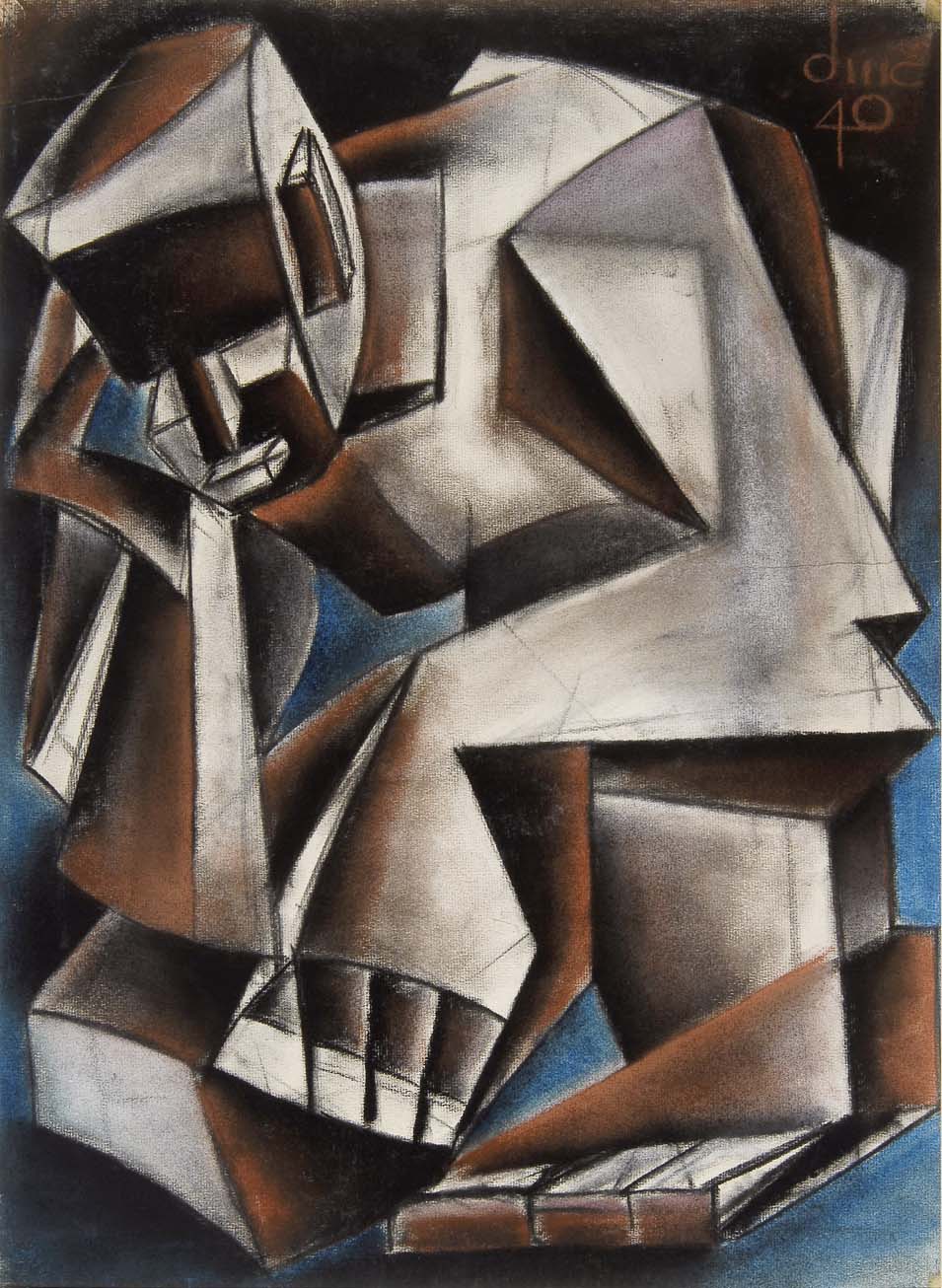 |
Aaron Douglas (1899-1979)
Portrait of a Lady, 1950
Watercolor on paper
Image size (sight): 14-1/2 x 11 in.;
Framed: 21-1/4 x 17-3/4 in.
|
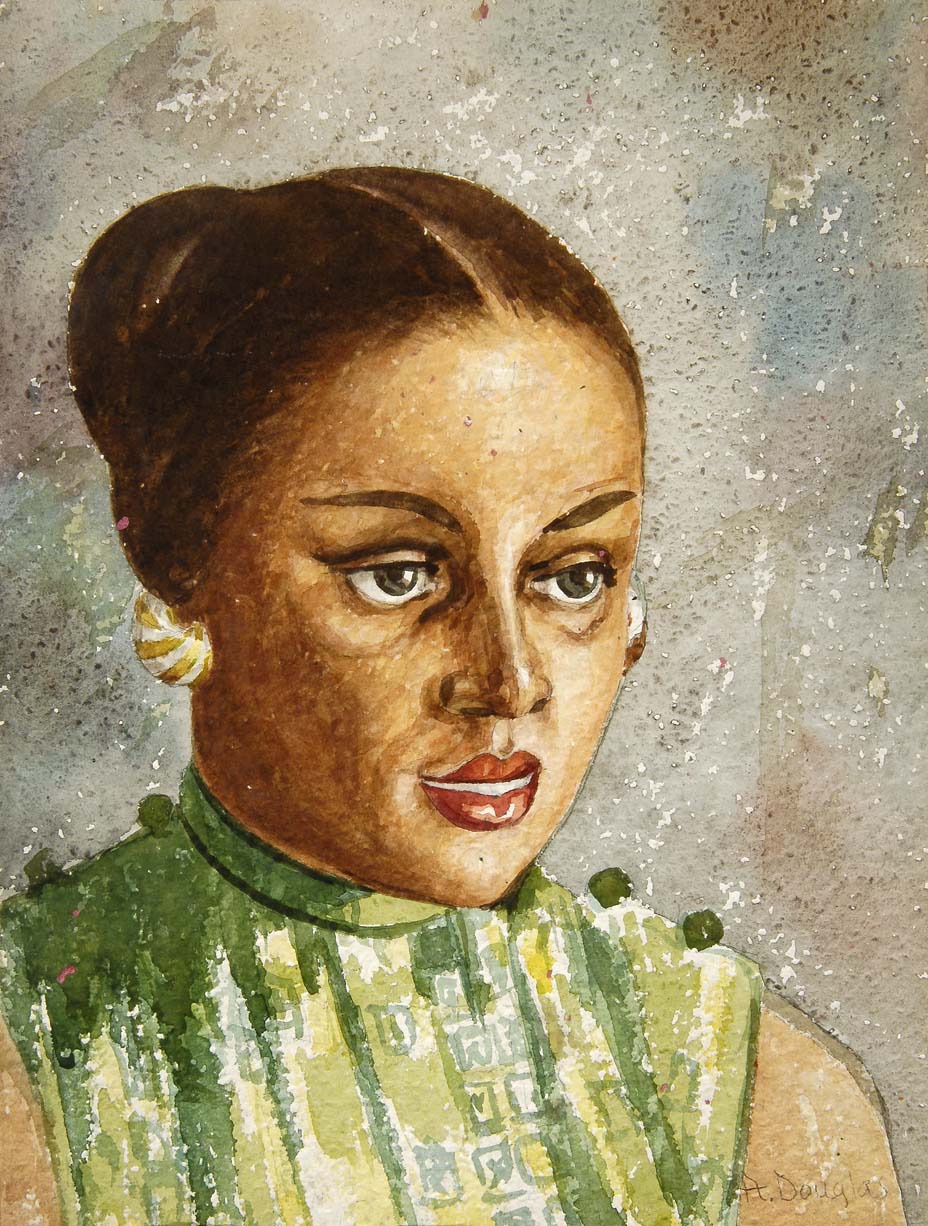
Aaron Douglas: Art © Heirs of Aaron Douglas/Licensed by VAGA, New York, NY |
William McKnight Farrow (1884-1967)
Ringling House, c. 1928
Etching
Image size: 4-1/8 x 3-3/8 in;
Framed: 12-1/2 x 11-1/2 in.
|
 |
Allan Randall Freelon (1895-1960)
Road Menders, 1935
Aquatint
Image size: 7-7/8 x 10 in.;
Framed: 17-3/8 x 18-3/4 in.
|
 |
Allan Randall Freelon (1895-1960)
Building the Bridge, c. 1930
Drypoint
[Marked: 35]
Image size: 8-7/8 x 6 in.;
Framed: 19-1/2 x 15-3/4 in.
|
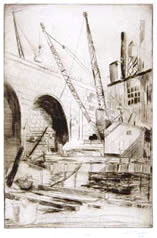 |
|
|
Rex Gorleigh (1902-1987)
Planting, 1973
Six color block print
Edition no.: 42/50
Image size (sight): 17-3/4 x 11-3/4 in.;
Framed: 23-3/4 x 17-3/4 in.
|
 |
Margo Humphrey (born 1942)
San Antonio Passage, 1988
One color lithograph
Edition no.: 2/10
Image size: 19 x 24-1/2 in.;
Framed: 29 x 34-1/4 in.
|
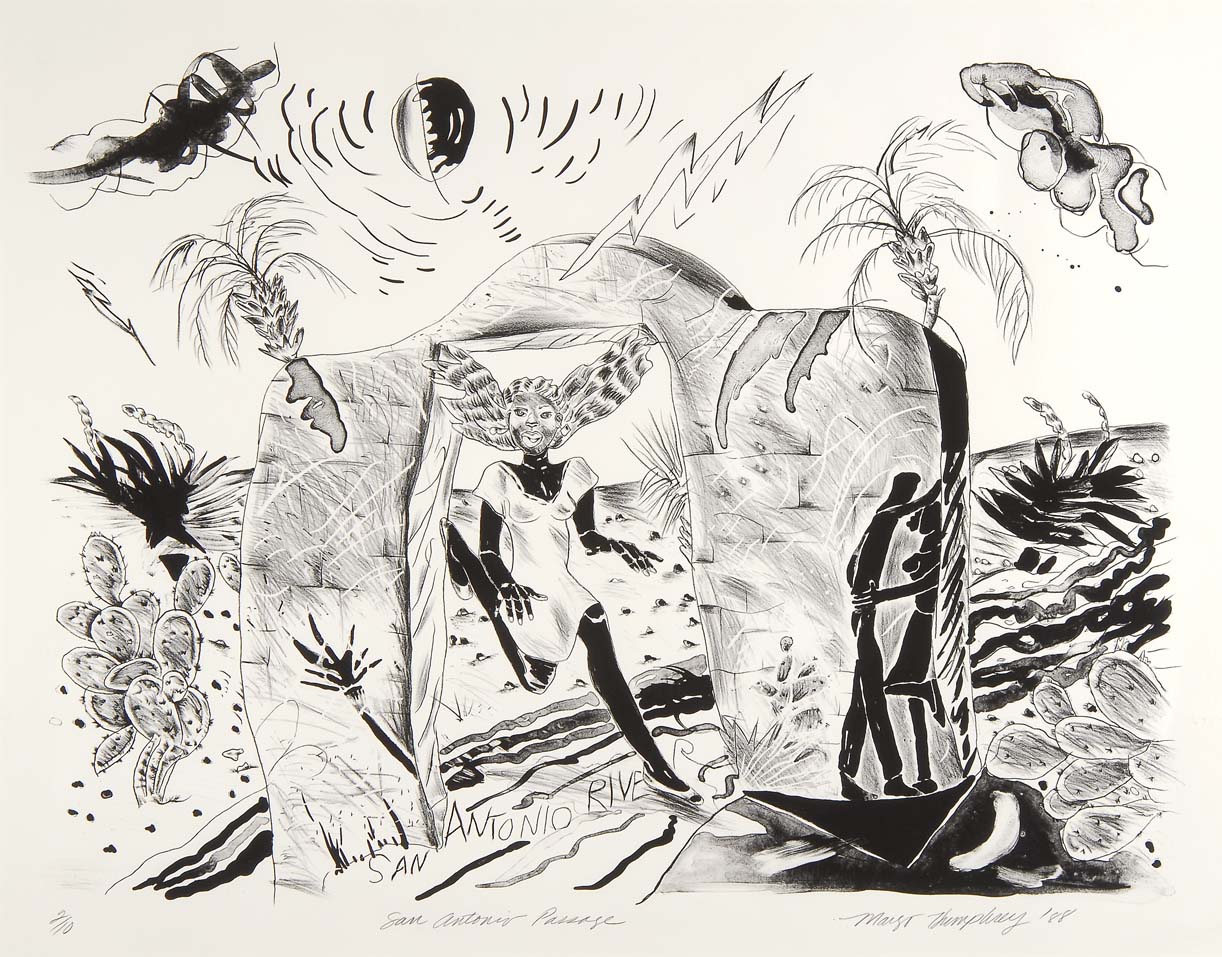 |
William Henry Johnson (1901-1971)
Jitterbugs III, 1941-42
Pochoir
Image size (sight): 16-1/2 x 10-1/2 in.;
Framed: 27-1/2 x 21-1/2 in.
|
 |
Sargent Johnson (1888-1967)
Singing Saints, 1940
One color lithograph
Edition no.: 138/150
Image size: 12-1/8 x 9-1/4 in.;
Framed: 23 x 17 in.
|
 |
Lois Mailou Jones (1905-1998)
A Shady Nook, Le Jardin du Luxembourg, Paris,
1991
Color screen print
Edition no.: Artist's Proof 21/22
Image size: 27-1/8 x 32-3/8 in.;
Framed: 38-1/4 x 42-1/4 in.
|
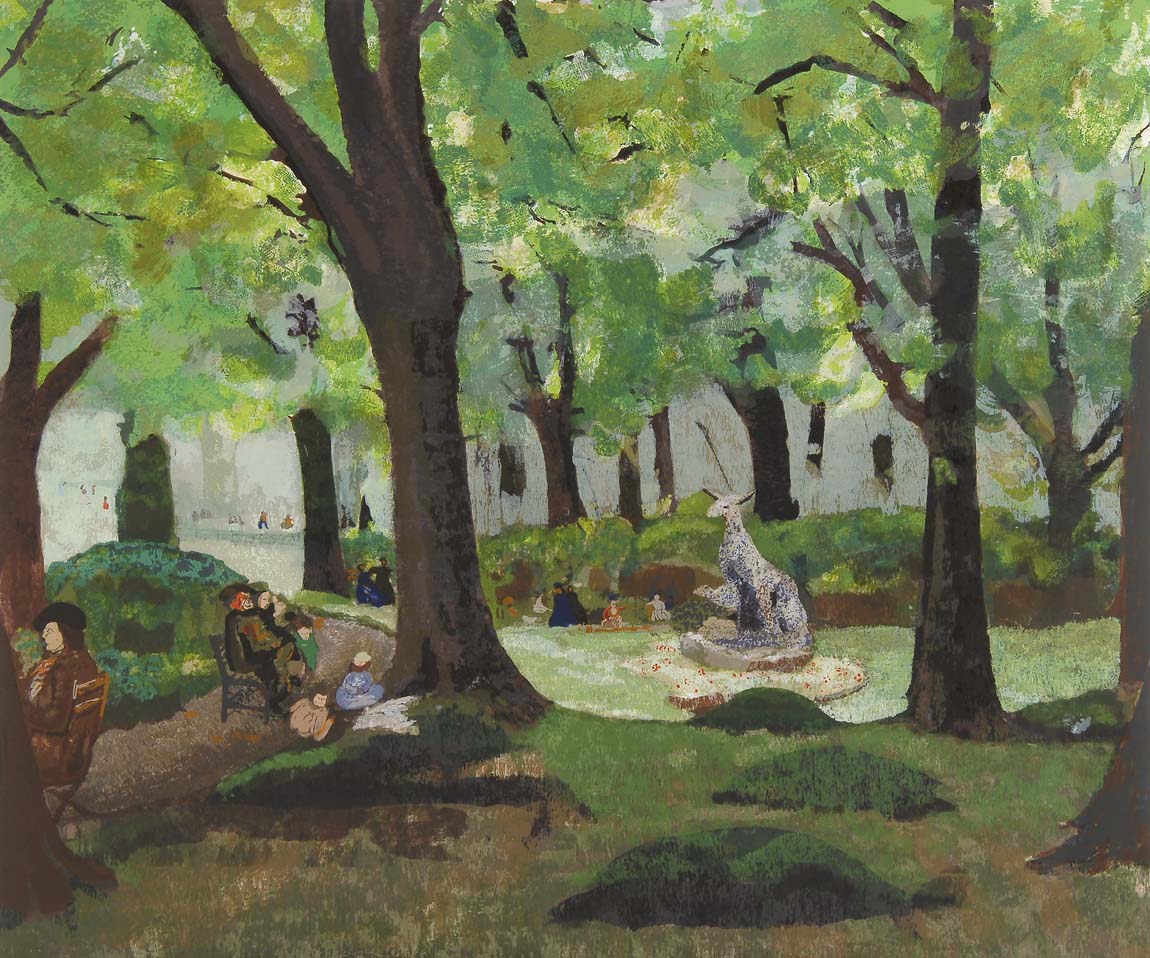 |
Paul Keene (1920-2009)
Seated Figure, 1947
One color woodcut
Edition no.: Artist's Proof, edition of 20
Image size: 10-1/4 x 8-3/4 in.;
Framed: 19-1/2 x 17-1/2 in.
|
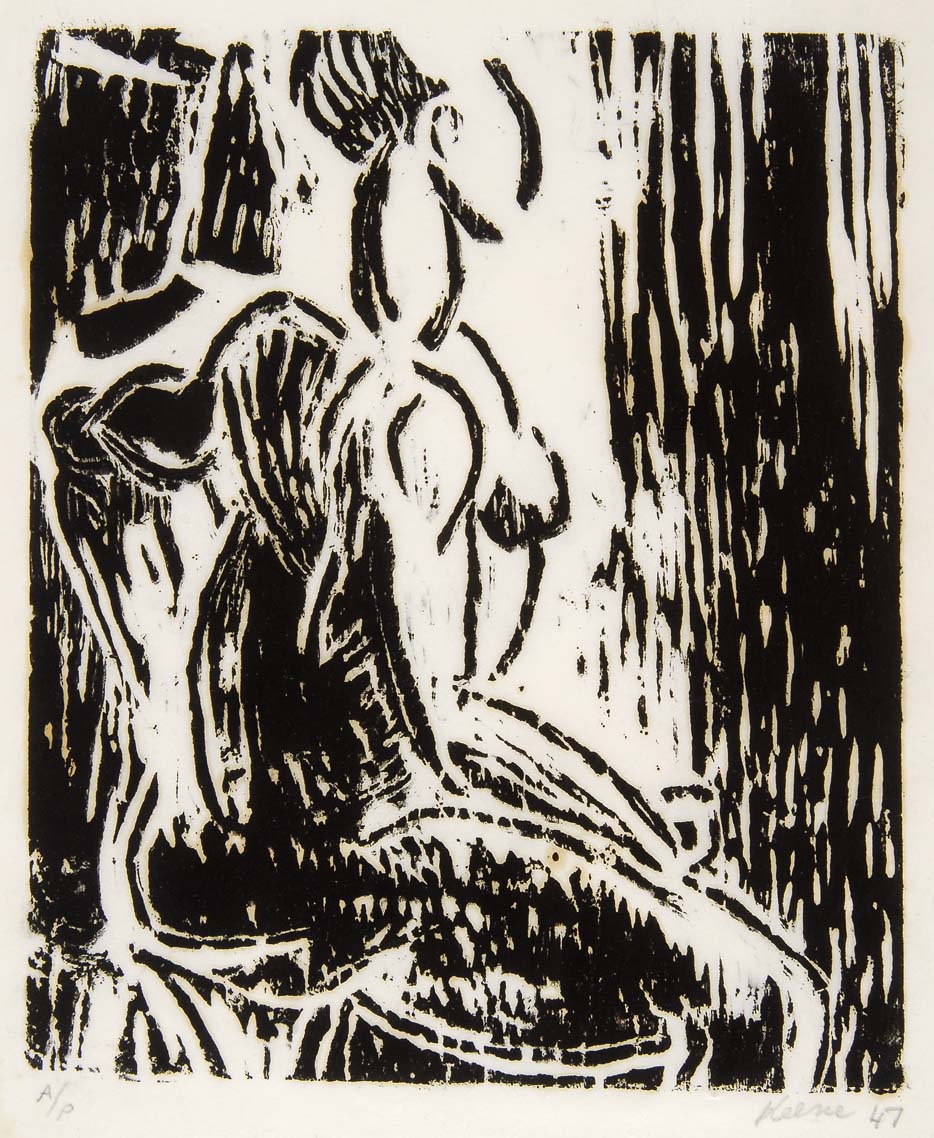 |
|
|
Jacob Lawrence (1917-2000)
Carpenters, 1977
Color lithograph
Edition no.: 52/300
Image size: 18 x 22 in.;
Framed: 27-1/2 x 31 in.
|
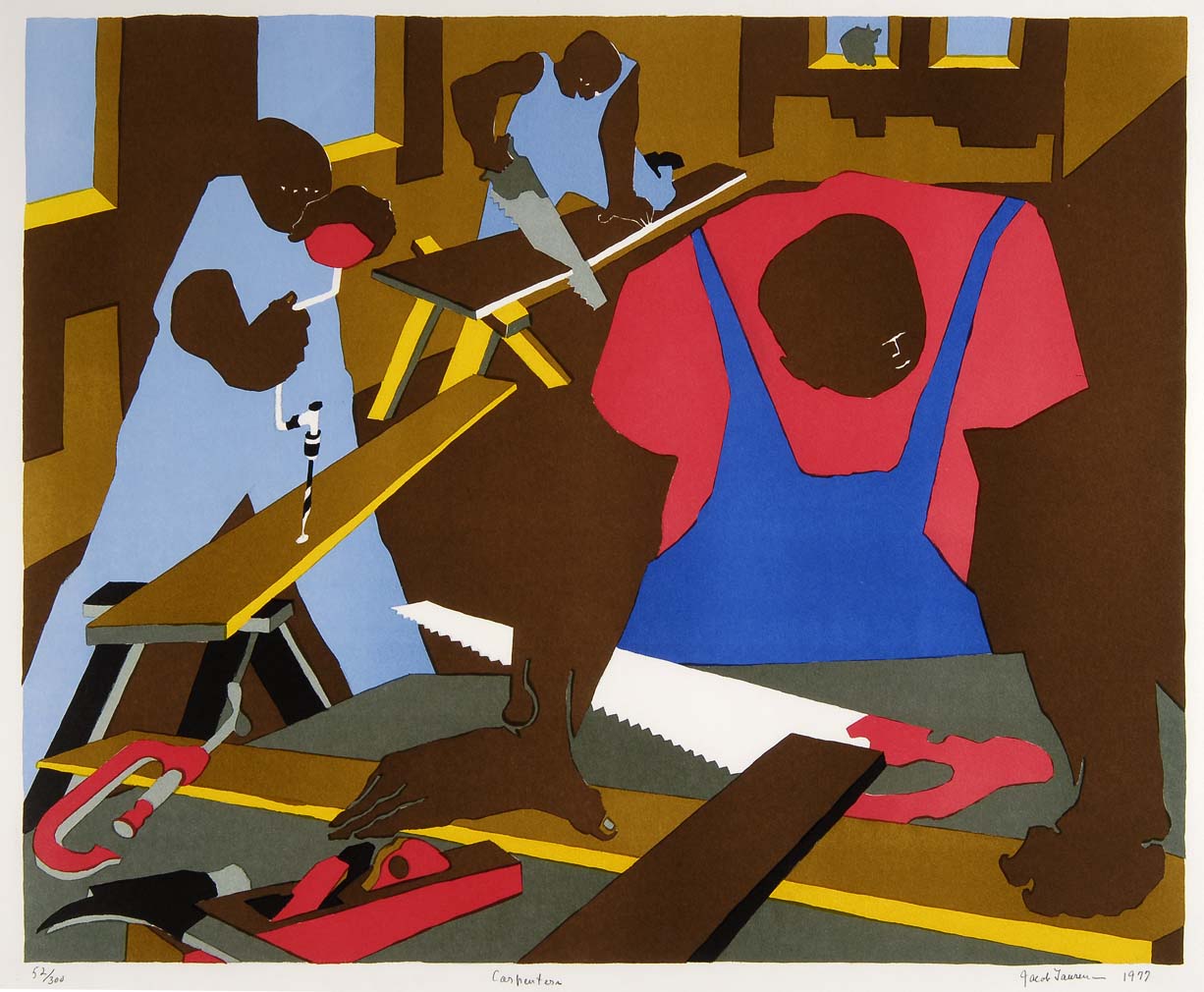 |
Jacob Lawrence (1917-2000)
Two Rebels, 1963
One color lithograph
Edition of 50
Image size (sight): 28-1/2 x 19 in.;
Framed: 35 x 25-1/2 in.
|
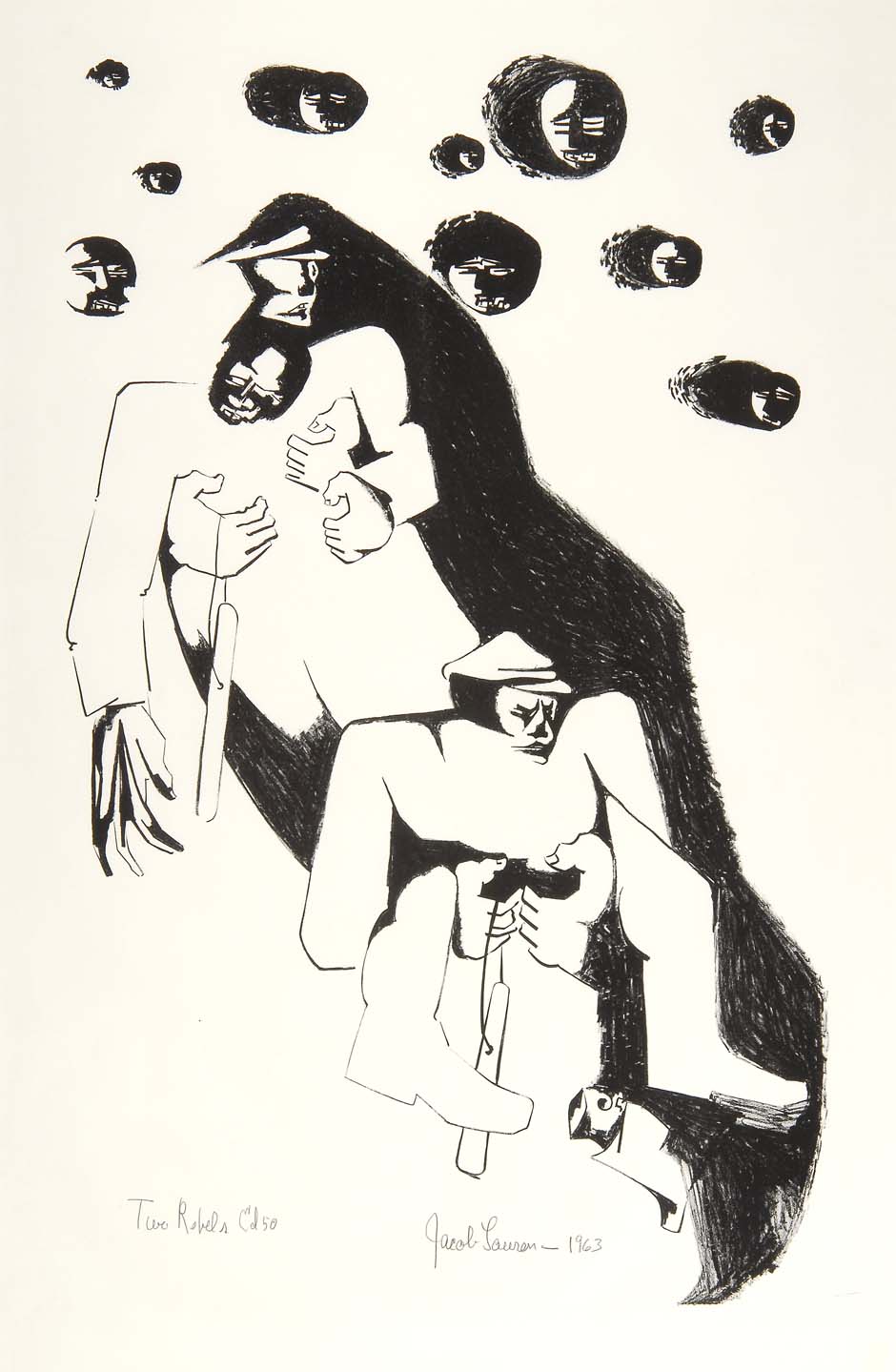 |
Norman Lewis (1909-1979)
Shorty George, not dated
Lithograph
Edition no.: 3/14
Image size: 9 x 6 in.;
Framed: 17-3/4 x 15 in.
|
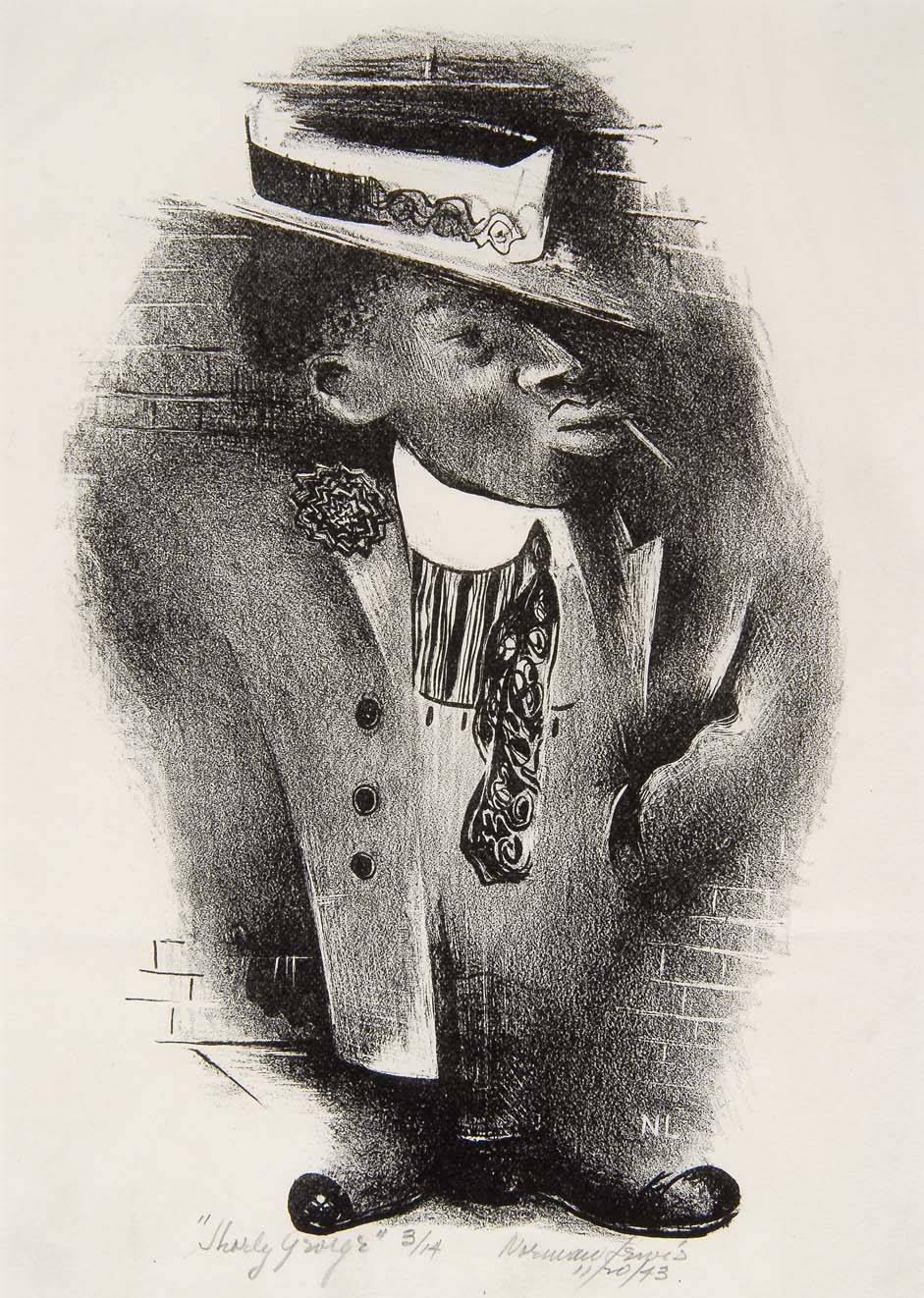 |
Lionel Lofton (born 1954)
Embracing, 1992
One color lithograph
Edition no.: 33/50
Image size: 18-1/2 x 26-1/2 in.;
Framed: 28-1/2 x 35-1/4 in.
|
 |
Bert Long (1940-2013)
We Love, We Give, We Die, We Go Someplace,
We Love, 1996
Color lithograph
Edition no.: 18/30
Image and paper size: 29-1/2 x 38 in.;
Framed 33-3/4 x 42 in.
|
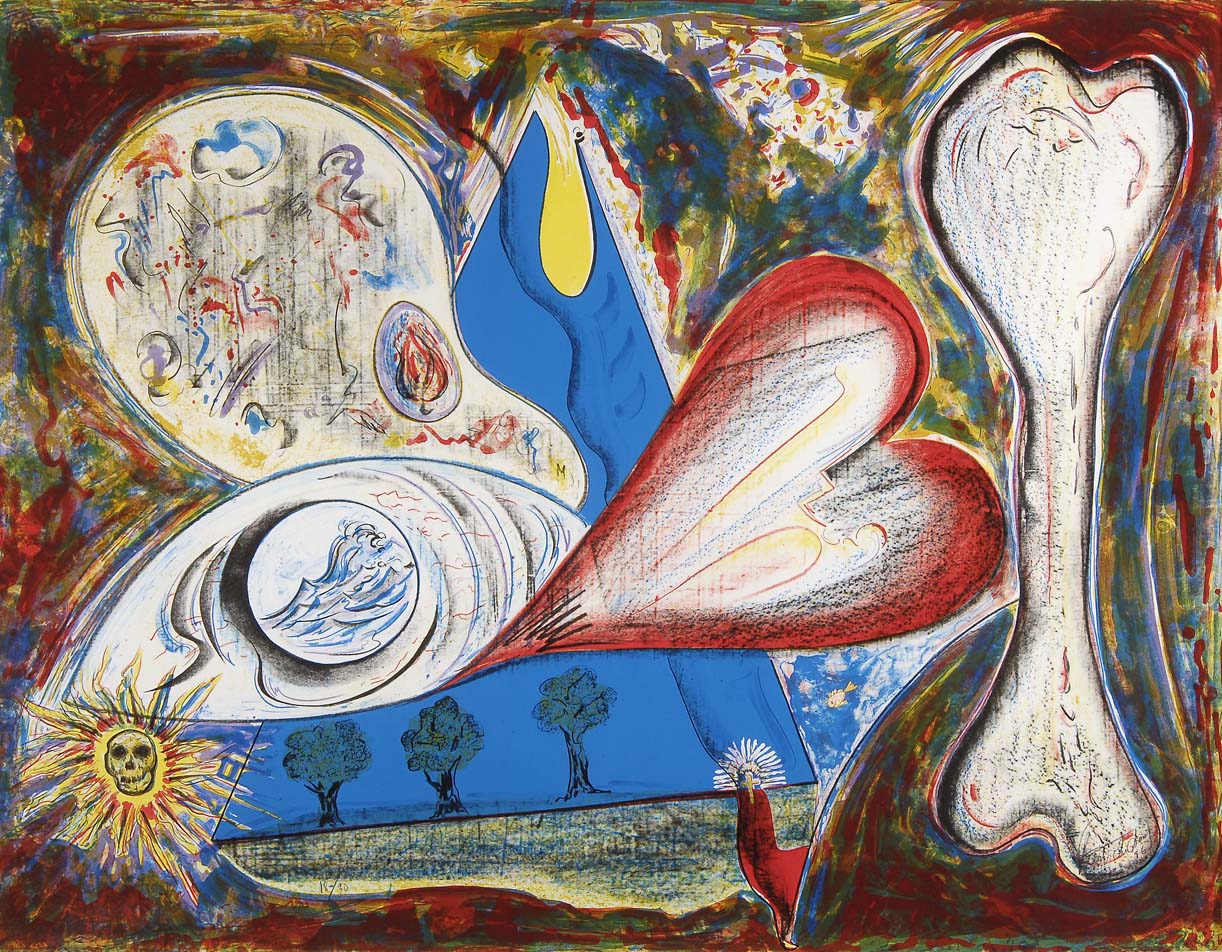 |
Whitfield Lovell (born 1959)
Chance, 2002
Iris print with unique hand-colored playing cards
Edition no.: 9/50
Image and paper size: 16 x 21 in.;
Framed: 26 x 21 in.
|
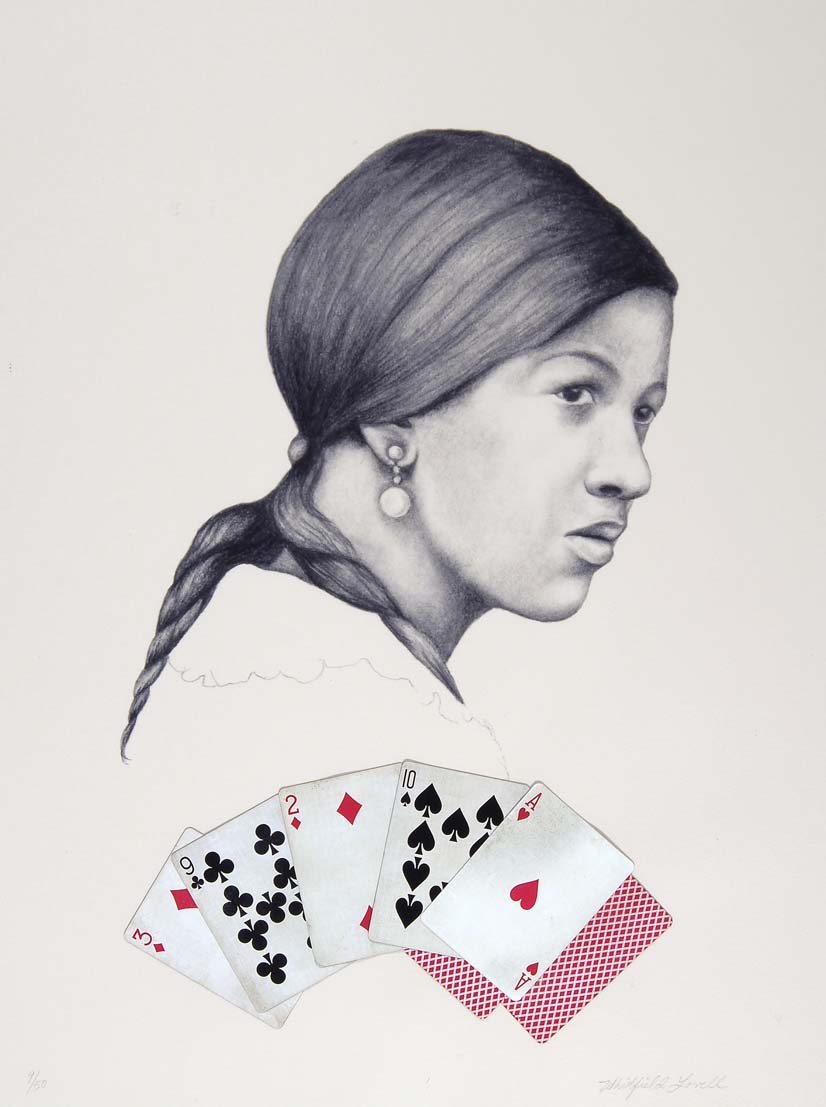 |
Sam Middleton (born 1927)
Untitled (Abstraction), 1961
Gouache on paper
Image size (sight): 15-3/4 x 22-1/2 in.;
Framed: 26 x 32-1/8 in.
|
 |
|
|
Ike E. Morgan (born 1958)
Still Life, 1990
Pastel and acrylic paint on paper
Image size: [ ];
Framed: 27-1/2 x 22-3/4 in.
|
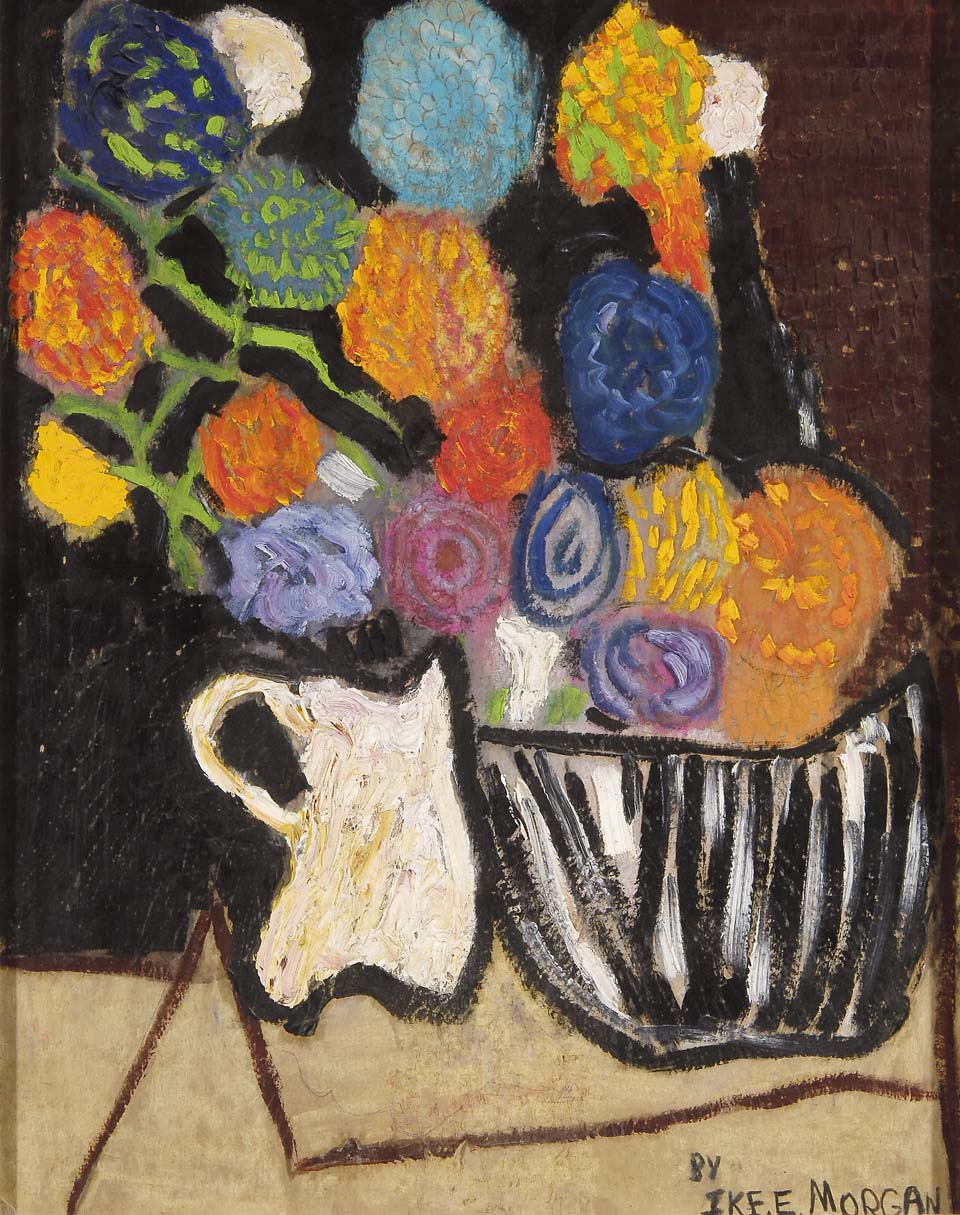 |
William Pajaud (1925-2005)
I'll Be a Woman Tomorrow, 1970
One color lithograph
Edition no.: 41/62
Image size (sight): 25 x 19 in.;
Framed: 33 x 27 in.
|
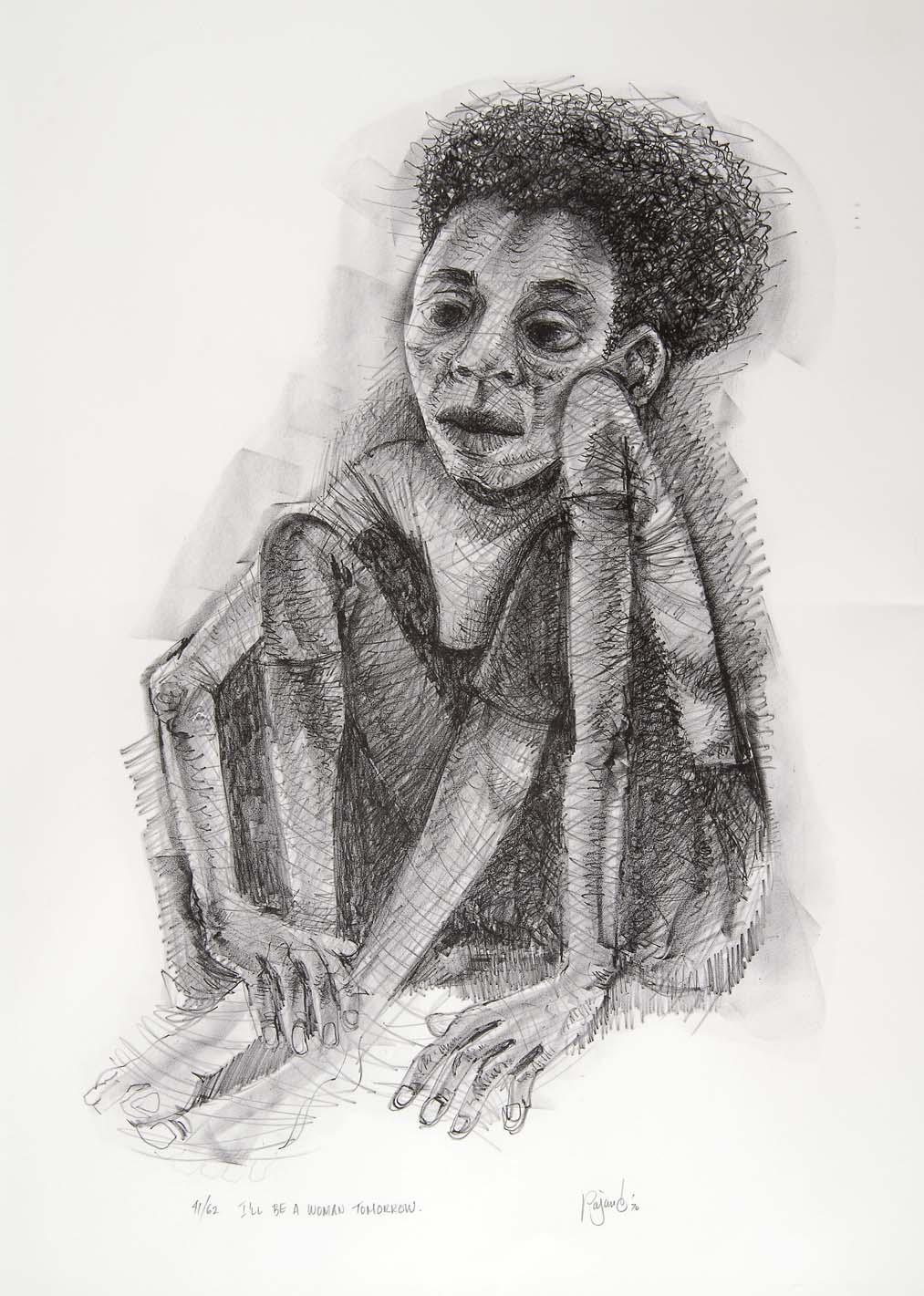 |
Alison Saar (born 1956)
Black Snake Blues, 1994
Color lithograph
Image size (sight): 21-1/2 x 29-1/2 in.;
Sheet: 22 x 30 in.;
Framed: [ ]
|
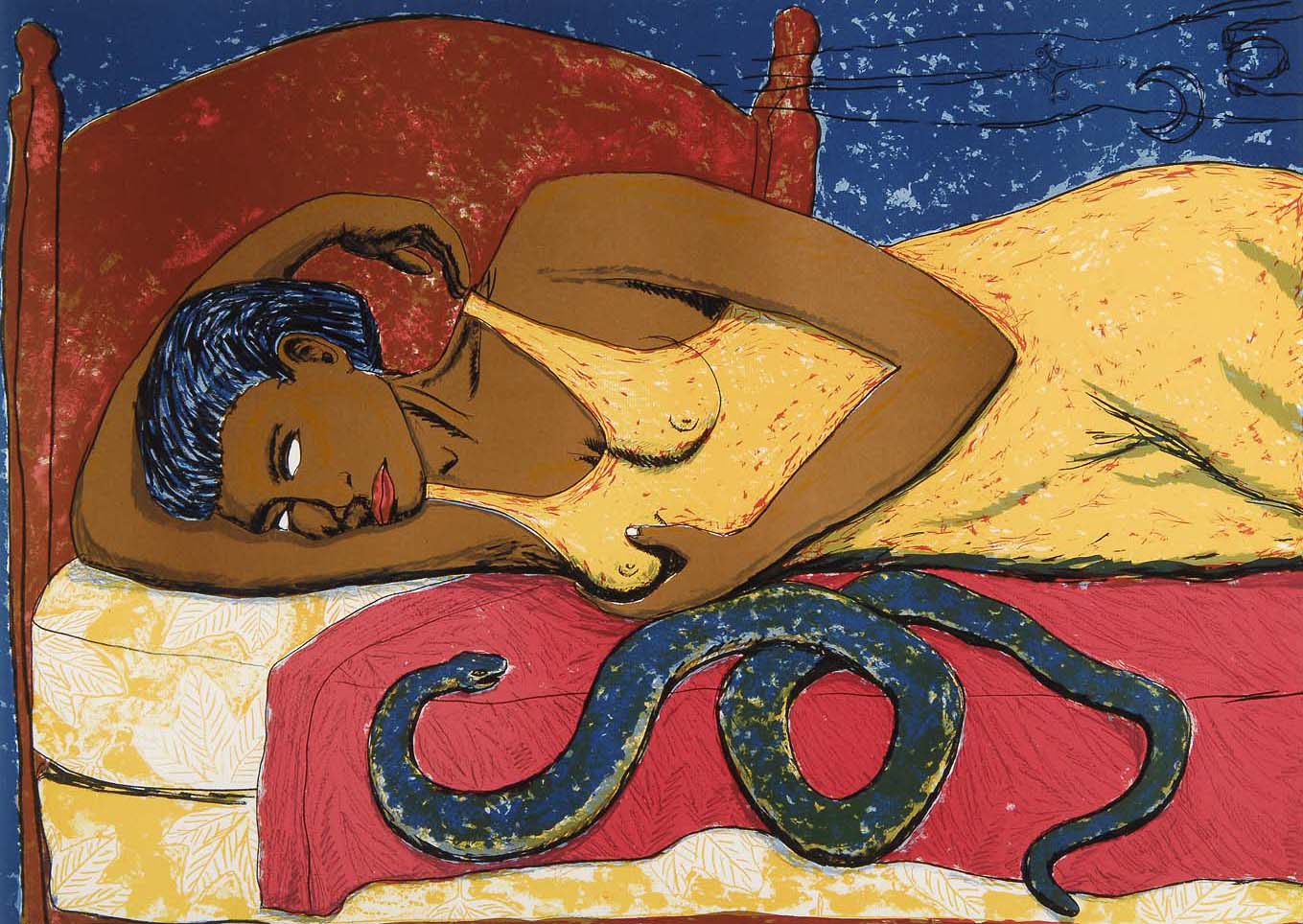
|
Charles Louis Sallee, Jr. (born 1911-2006)
Boogie Woogie, 1941
One color line etching
Edition no.: 10/10
Image size: 5-7/8 x 3-9/16 in.;
Framed: 16-1/2 x 13-1/2 in.
|
 |
William E. Scott (1884-1964)
Old Woman, 1912
Soft-ground etching or one color
transfer lithograph (?)
Image size (sight): 10-1/4 x 8-1/4 in.;
Framed: 20-1/4 x 17-1/4 in.
|
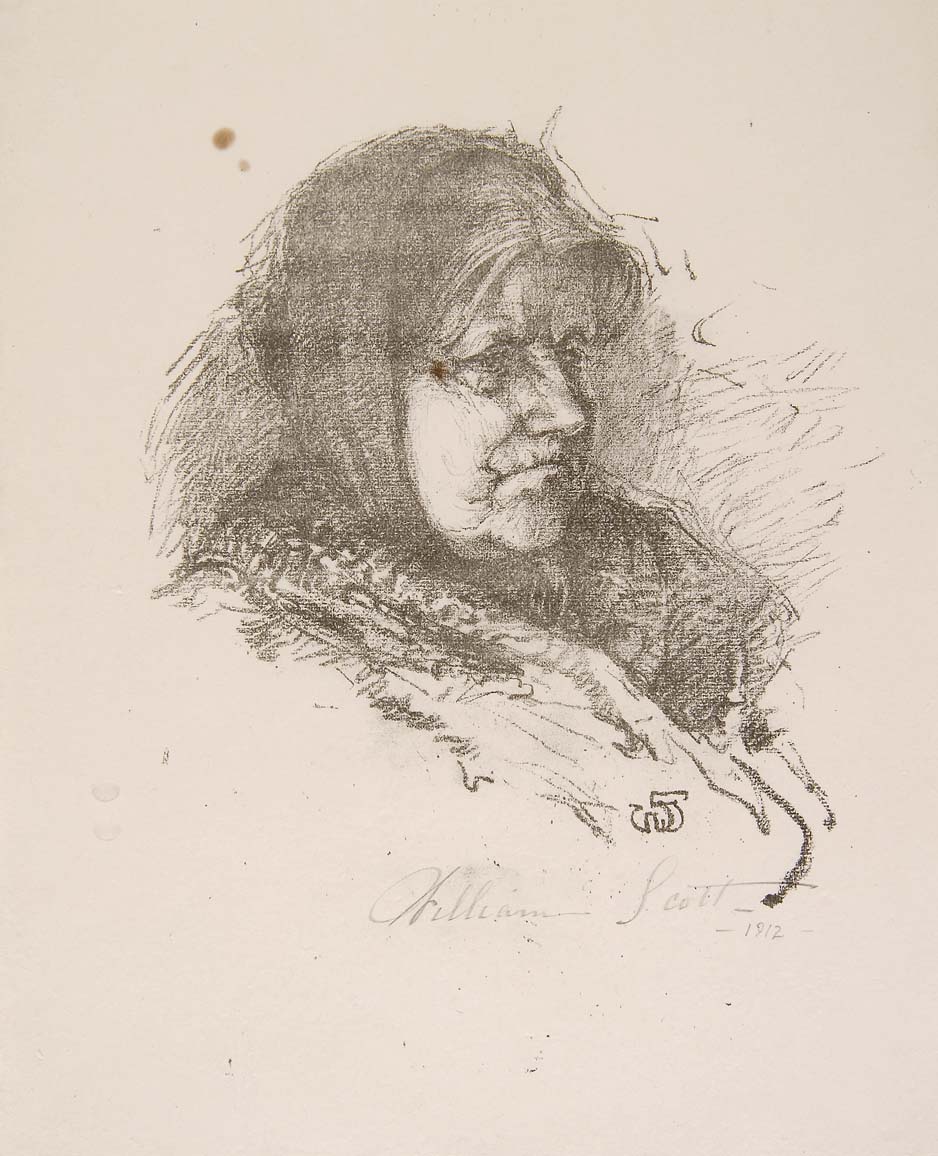 |
Charles Sebree (1914-1985)
Harlequin, 1954
Pen and ink and gouache on handmade paper
Image size: 14-1/4 x 10 in.;
Framed: 27-1/2 x 23-1/8 in.
|
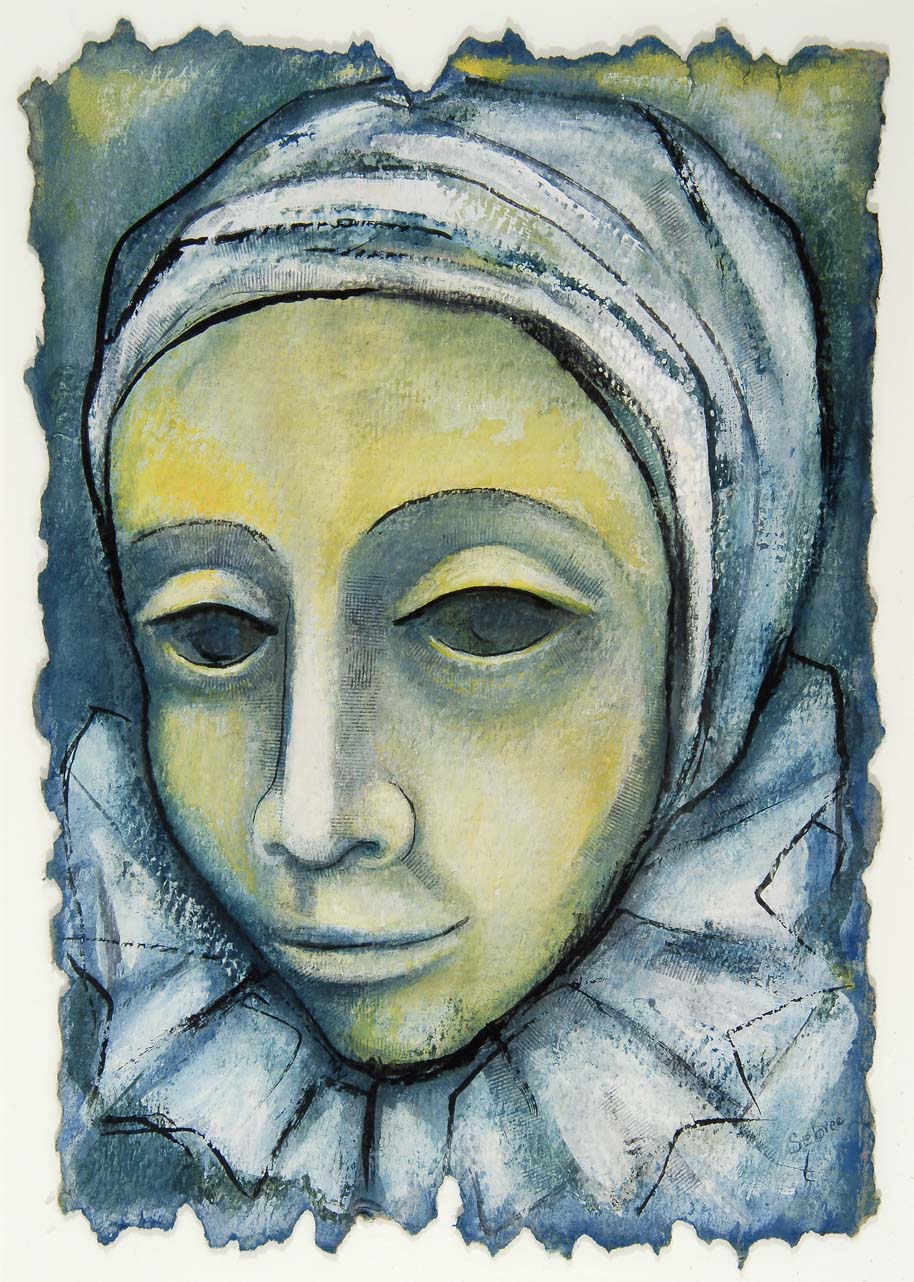 |
Albert A. Smith (1896-1940)
Untitled, 1930
One color line etching with drypoint
Edition no.: 9/50
Image size: 6-1/2 x 9-5/8 in.;
Framed: 17-3/4 x 20-1/2 in.
|
 |
William E. Smith (1913-1997)
The Lamp Post, 1938
Linoleum cut
Edition no.: 20/20
Image size: 9-1/2 x 6 in.;
Framed: 17-1/4 x 13-3/4 in.
|
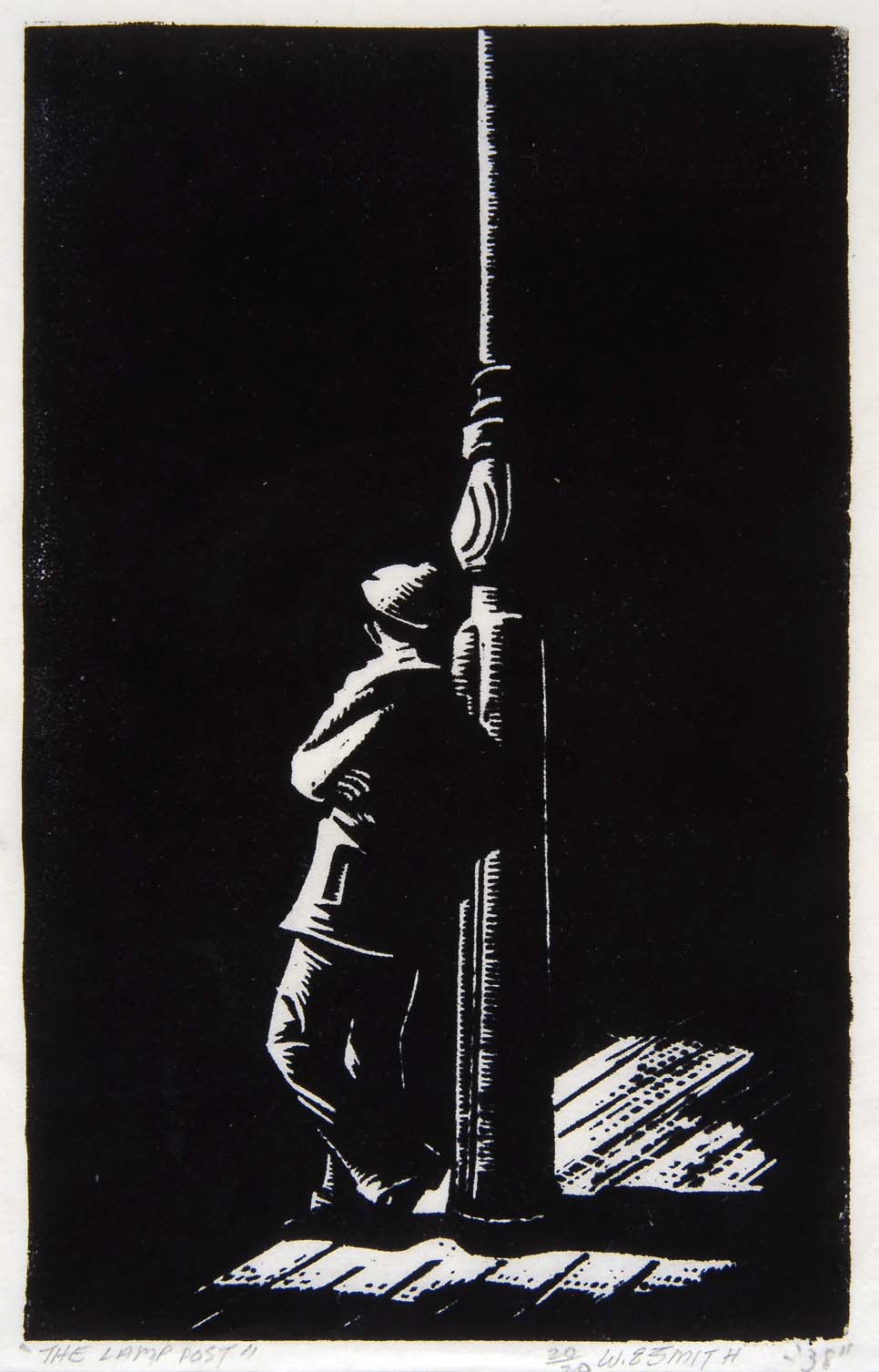 |
William E. Smith (1913-1997)
Pay Day, 1941
Linoleum cut
Edition no.: 20/20
Image size: 8-1/2 x 6 in.;
Framed: 19-1/2 x 15-1/2 in.
|
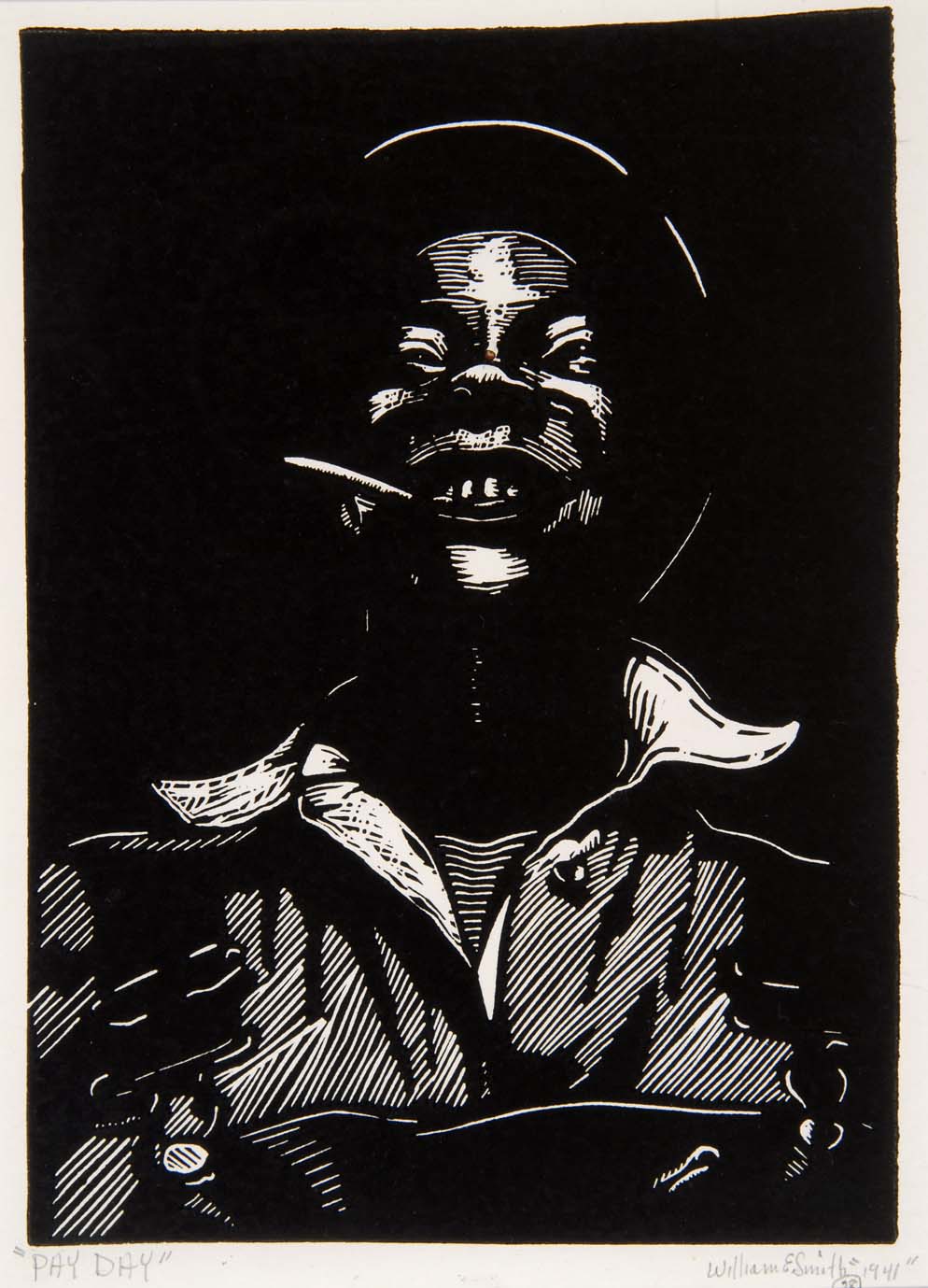 |
William E. Smith (1913-1997)
Recreation, 1944
Pen and ink with graphite on paper
Image size 12-1/8 x 10 in.;
Framed: 24-1/2 x 22-1/4 in.
|
 |
Raymond Steth (1916-1997)
Squatter, 1935
One color lithograph
Image size: 7-1/8 x 11-1/2 in.;
Framed: 19 x 23 in.
|
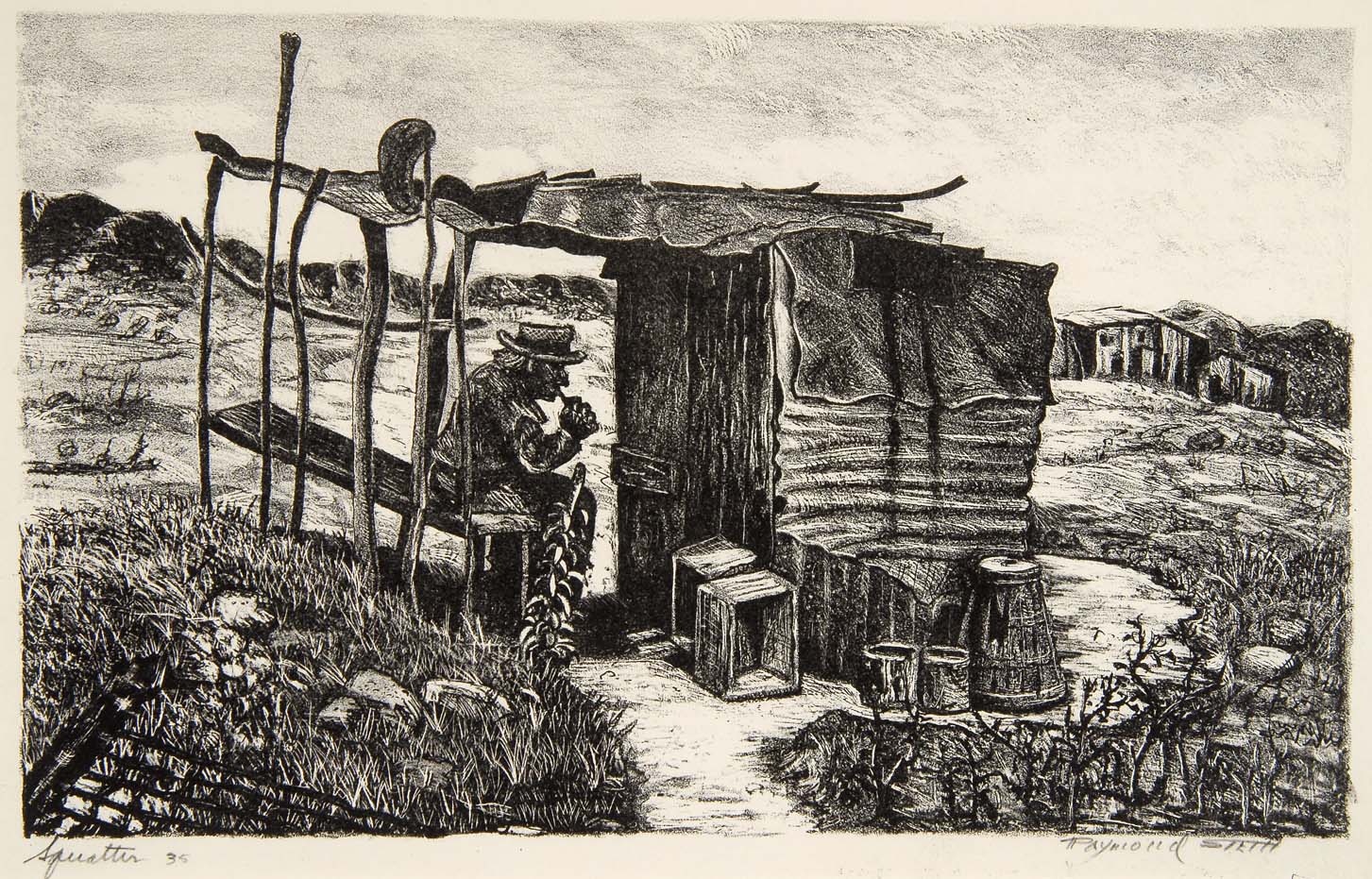 |
Henry Ossawa Tanner (1859-1937)
Shipwreck-Brittany, 1913
Etching
Image size: 7-1/8 x 9-1/8 in.;
Framed: 16 x 17-1/2 in.
|
 |
|
|
Henry Ossawa Tanner (1859-1937)
Gate of Tangier, 1910
Etching
Image size: 9-7/8 x 7-5/8 in.;
Framed: 18-5/8 x 17-5/8 in.
|
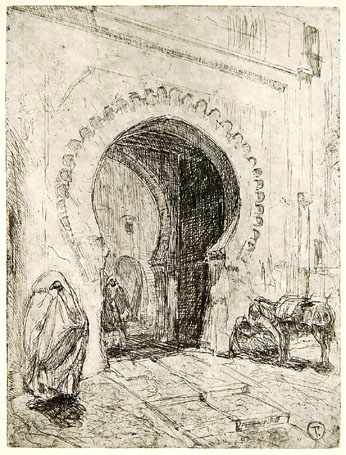
|
Henry Ossawa Tanner (1859-1937)
Christ Walking on Water, 1910
Etching
Image size: 7-3/4 x 9-7/8 in.;
Framed: 16-3/4 x 18-1/4 in.
|
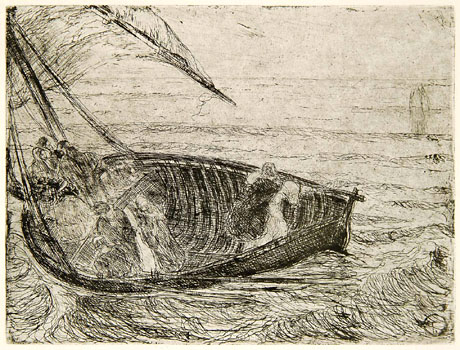
|
Alma Woodsey Thomas (1891-1978)
Wind and Flowers, 1973
Watercolor on paper
Image size (sight): 14-1/2 x 18 in.;
Framed: 24-1/4 x 27-3/4 in.
|
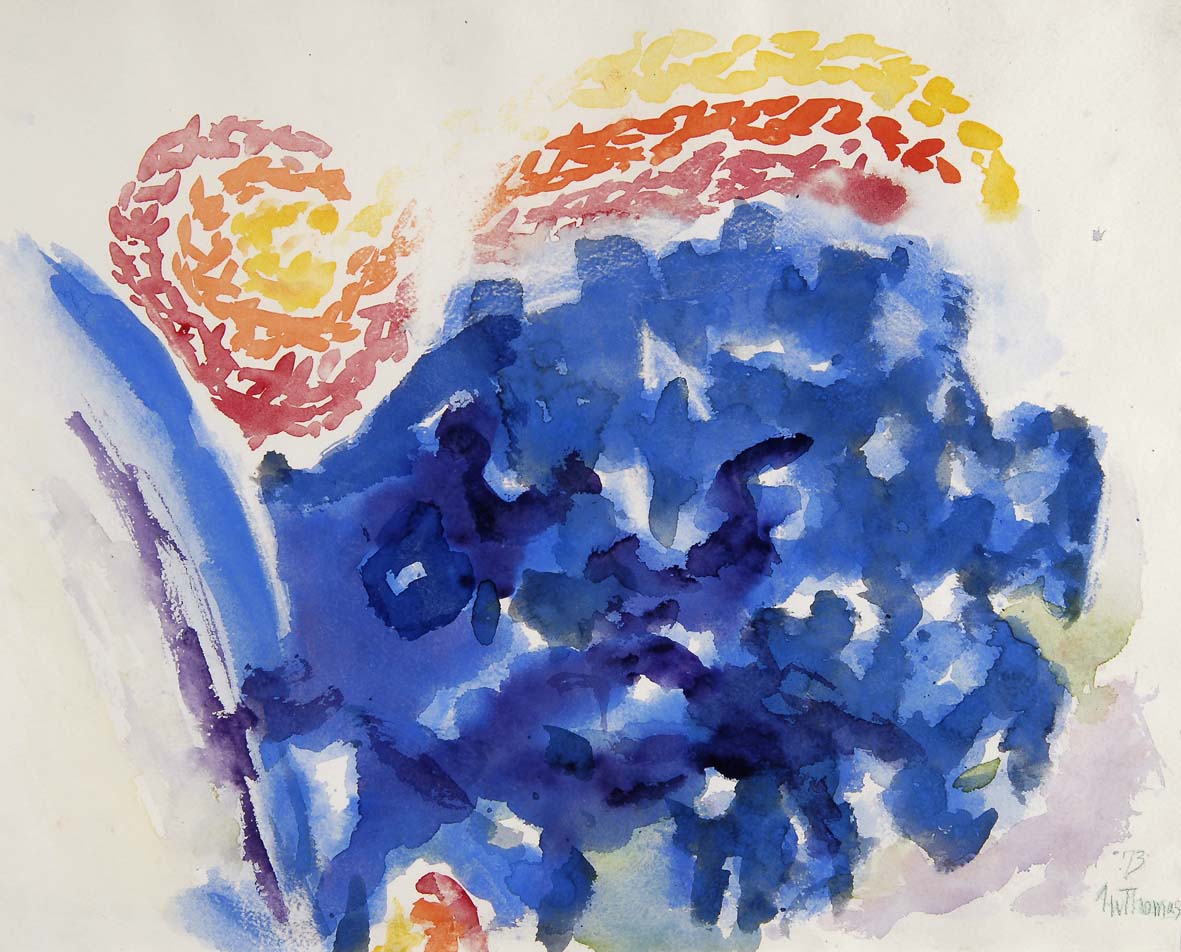 |
Dox Thrash (1893-1965)
Abraham, (first version), c. 1937
Etching and drypoint
Image size: 4-7/8 x 4 in.;
Framed: 15-1/2 x 13-1/2 in.
|
 |
|
|
Dox Thrash (1893-1965)
Study for Boats at Night, 1940
Pen and ink, ink wash, and graphite on paper
Image/paper size: 7-1/4 x 11-1/2 in.;
Framed: 15 x 19 in.
|
 |
James Lesesne Wells (1902-1993)
Negro Worker, 1938
One color lithograph
Edition no.: 3/35
Image size: [ ];
Framed: [ in.]
|
 |
Charles White (1918-1979)
Night Club Hostess, 1938-40
Ink on paper
Image size: 10 x 8 in.;
Framed 19-3/4 x 17-1/4 in.
|
 |
Charles White (1918-1979)
Wanted Poster Series, L-14, 1970
One color lithograph on yellow paper
Edition no.: 7/10
Image/paper size: 22 x 30 in.;
Framed: 29-1/4 x 36-1/4 in.
|
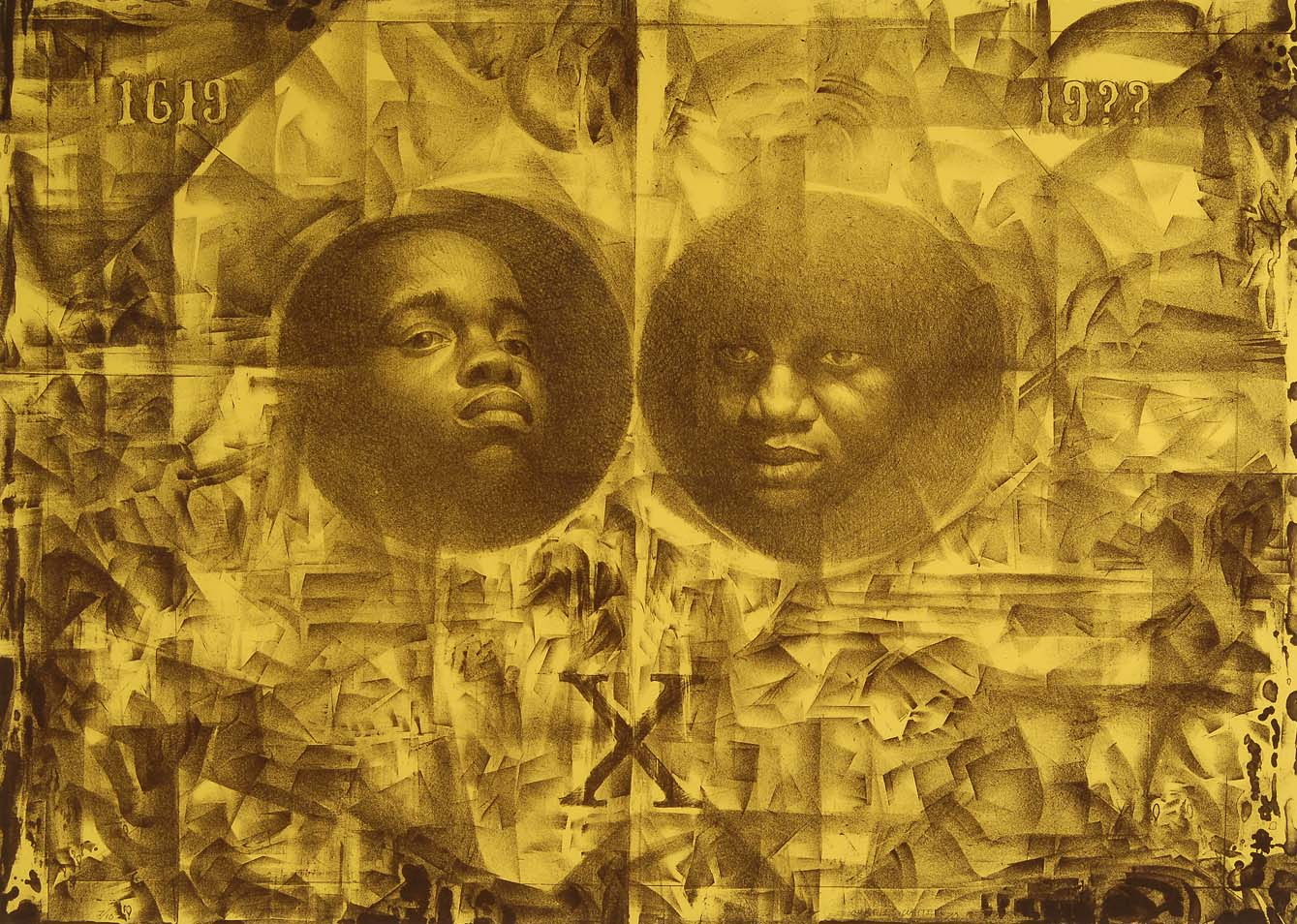 |
Charles White (1918-1979)
Frederick Douglass, not dated
One color line etching
Edition no.: Artist's Proof
Image and plate size: 23-1/2 x 19 in.;
Paper size: 29-7/8 x 21-3/4 in.
Framed: 35-1/4 x 27-1/4 in.
|
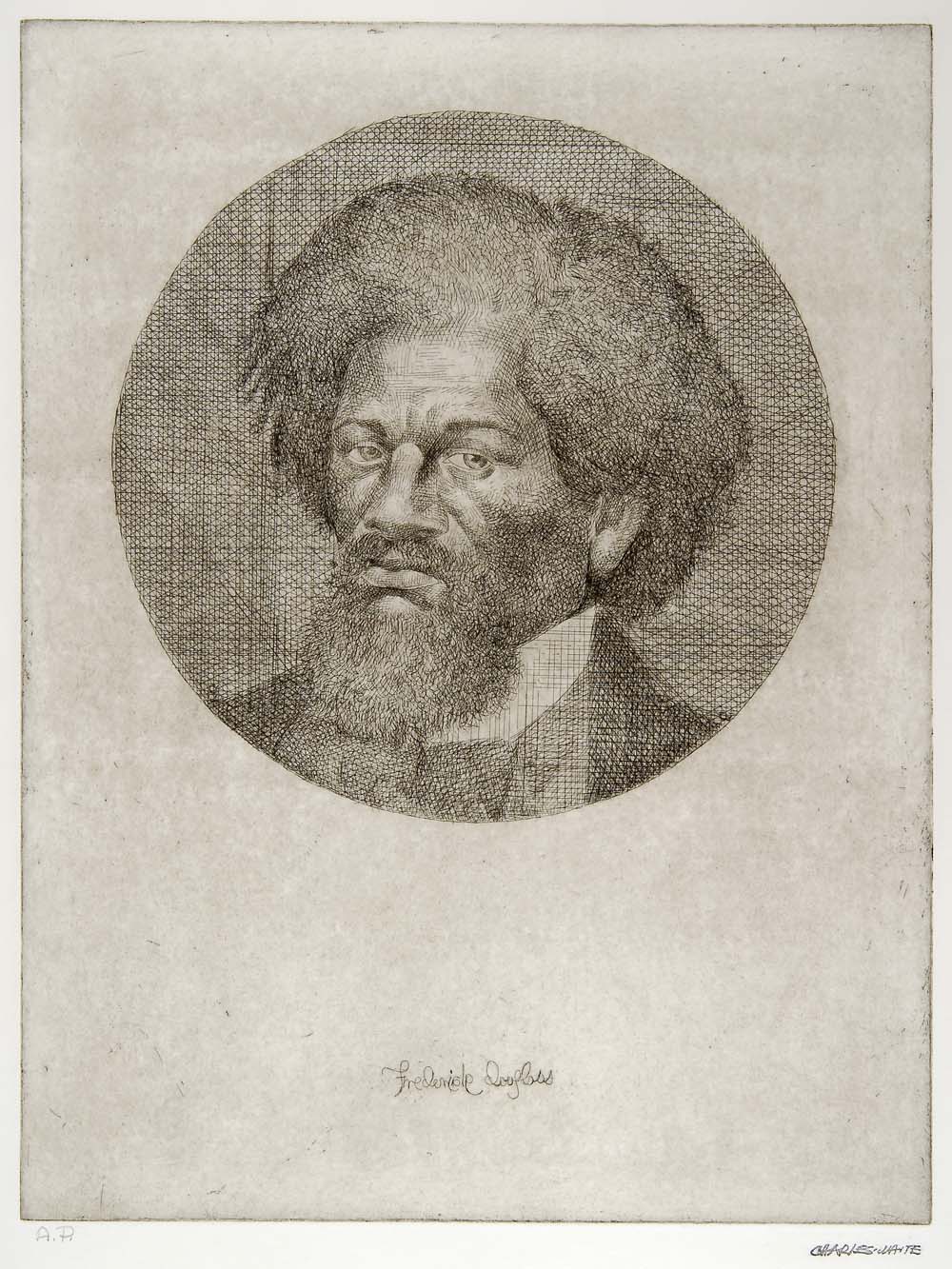 |
Walter Williams (1922-1988)
Thistle, 1966
Four color block print
Edition no.: 9/12
Image size: 11-1/2 x 22 in.;
Framed: 21 x 31 in.
|
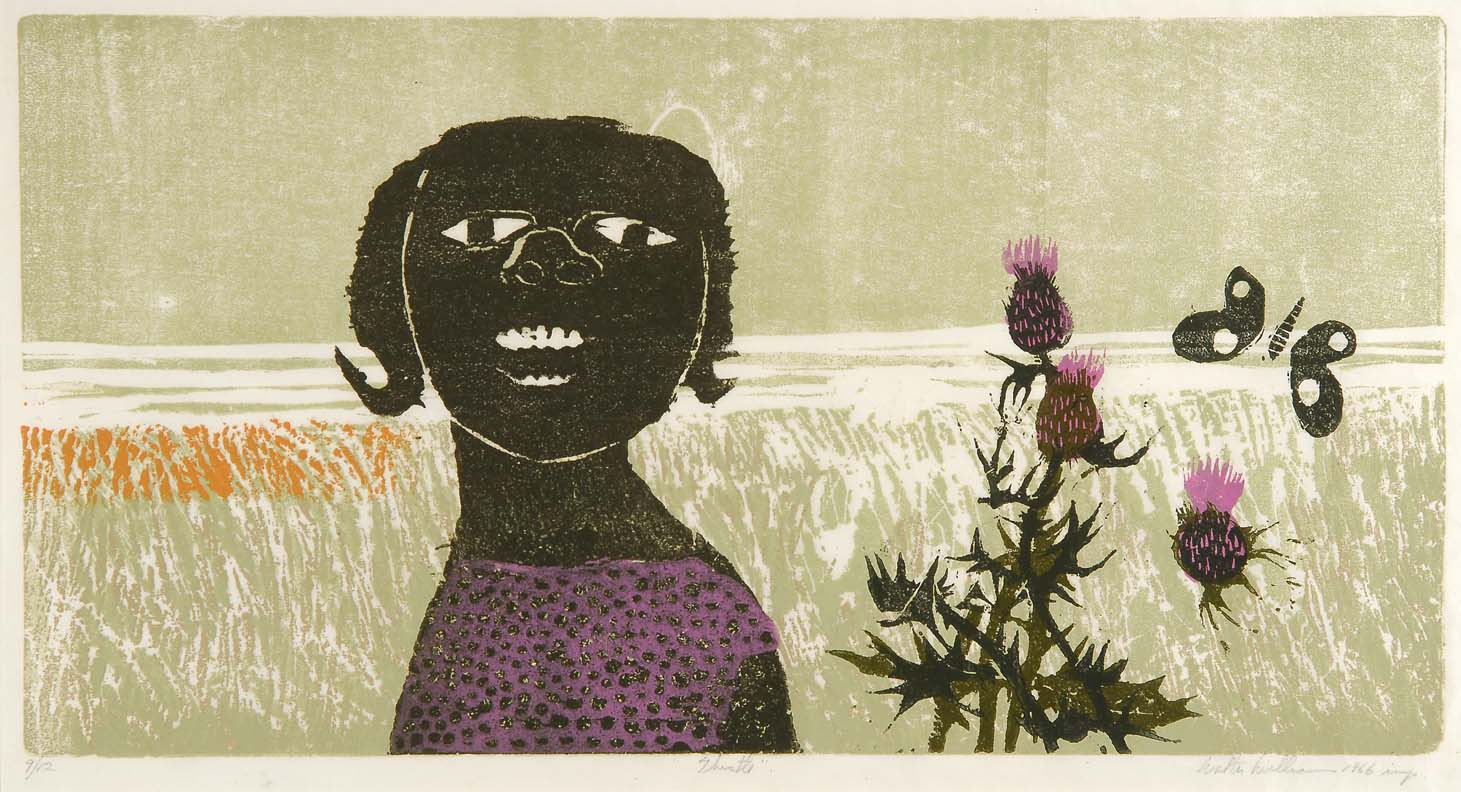 |
John Woodrow Wilson (born 1922)
Native Son, 1945
One color lithograph
Image size: 12-3/8 x 10-1/4 in.;
Framed: 23-3/4 x 21 in.
|

John Wilson: Art ©Estate of John Wilson/Licensed by VAGA, New York, NY |
John Woodrow Wilson (born 1922)
Street Car Scene, 1945
One color lithograph
Image size: 11-1/4 x 14-3/4 in.;
Framed: 20-1/2 x 23-3/4 in.
|

John Wilson: Art ©Estate of John Wilson/Licensed by VAGA, New York, NY |
Hale Aspacio Woodruff (1900-1980)
Sunday Promenade, 1939
Woodblock print
Image size: 9-3/4 x 7-3/4 in.; Framed: 28 x 24 in. |
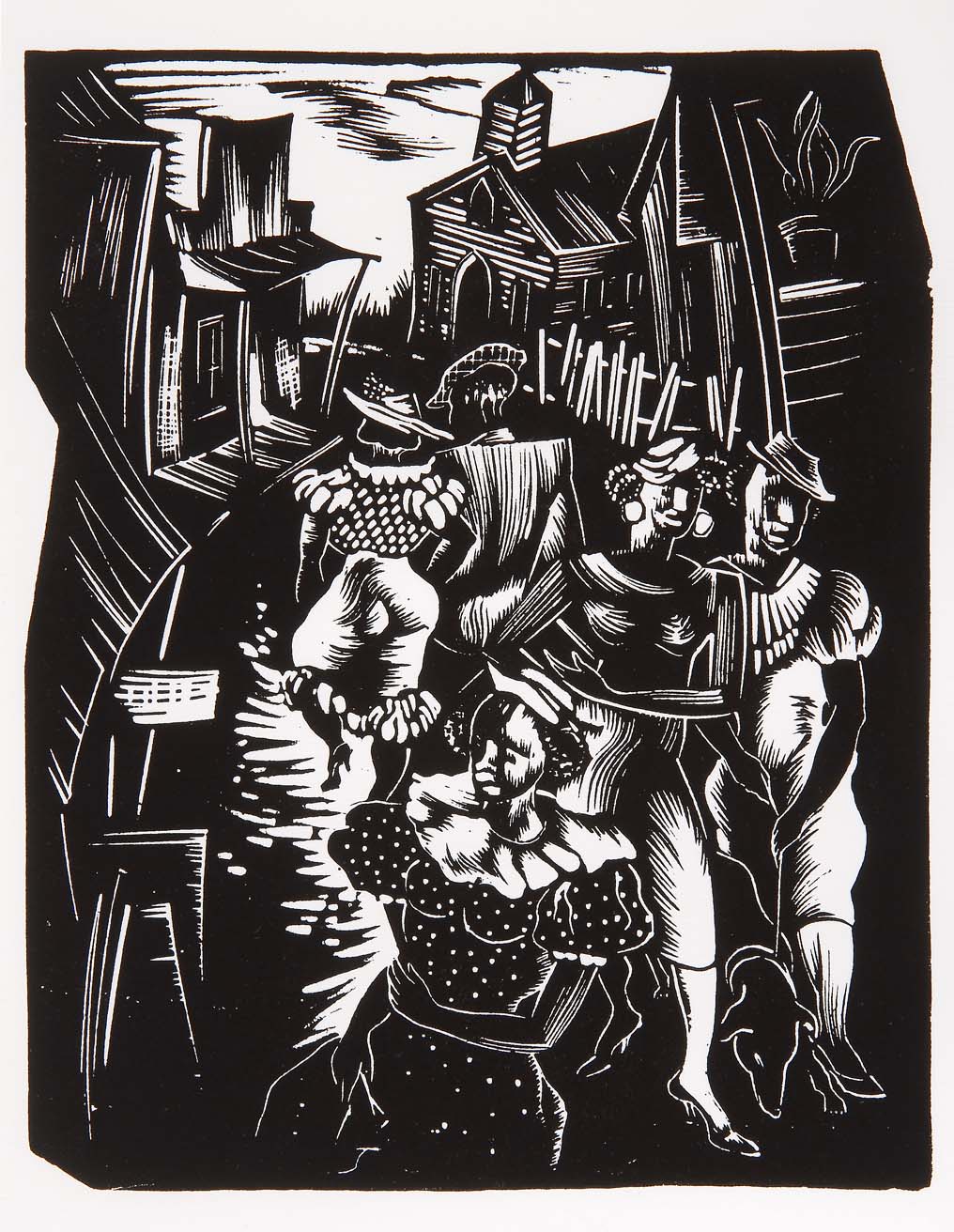
Hale Woodruff: Art ©Estate of Hale Woodruff/Licensed by VAGA, New York, NY |
Lawrence Arthur Jones, (1900-1996)
Section Hands, 1936
Etching, 5.9 x 4.9 in.
|
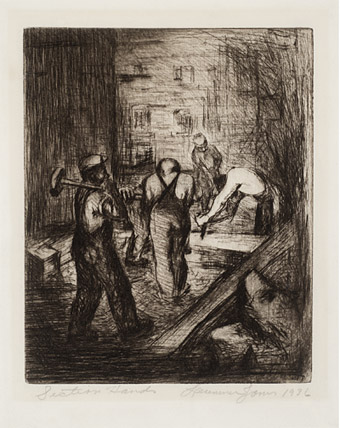
|



